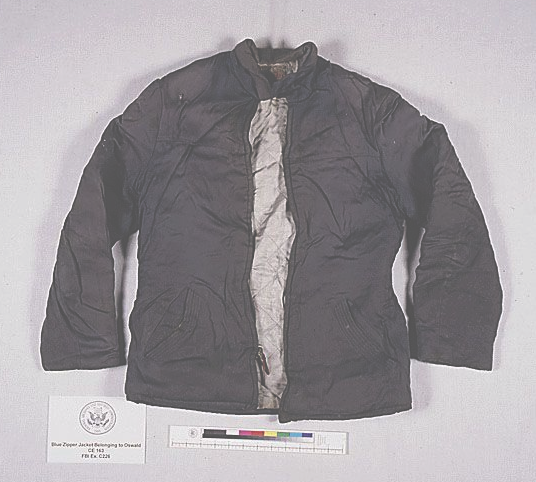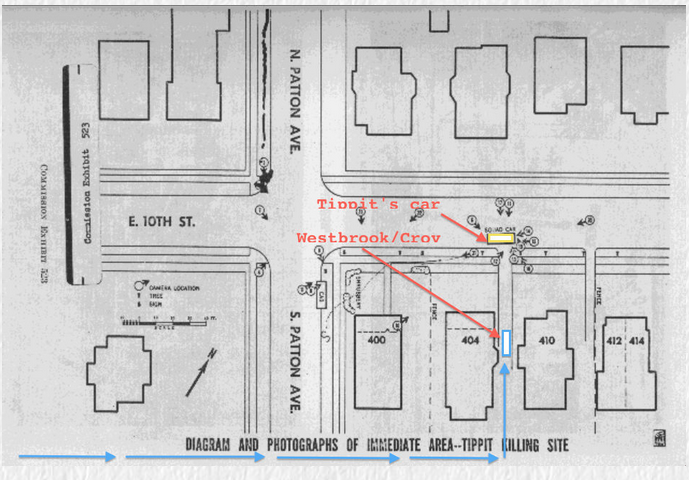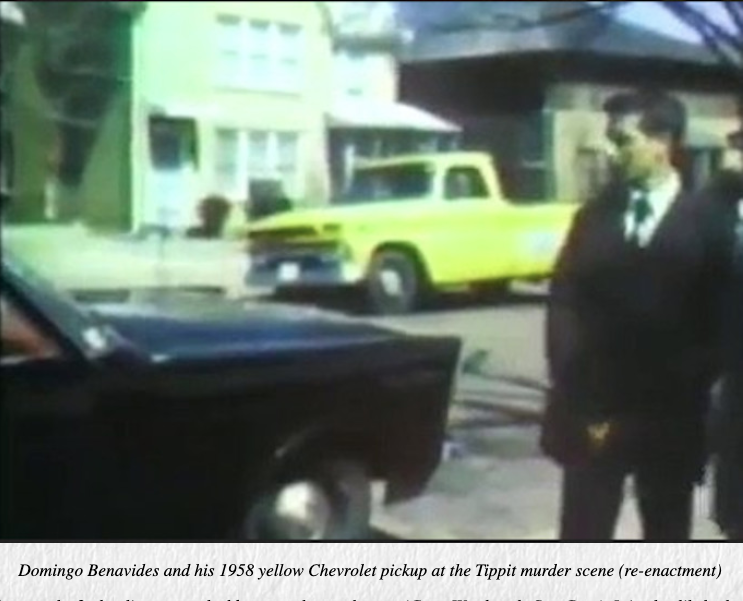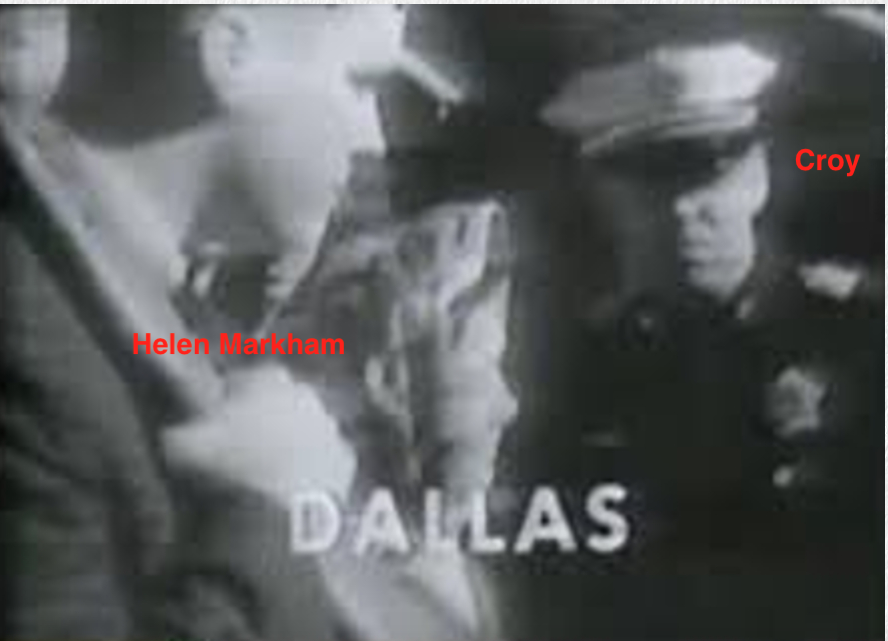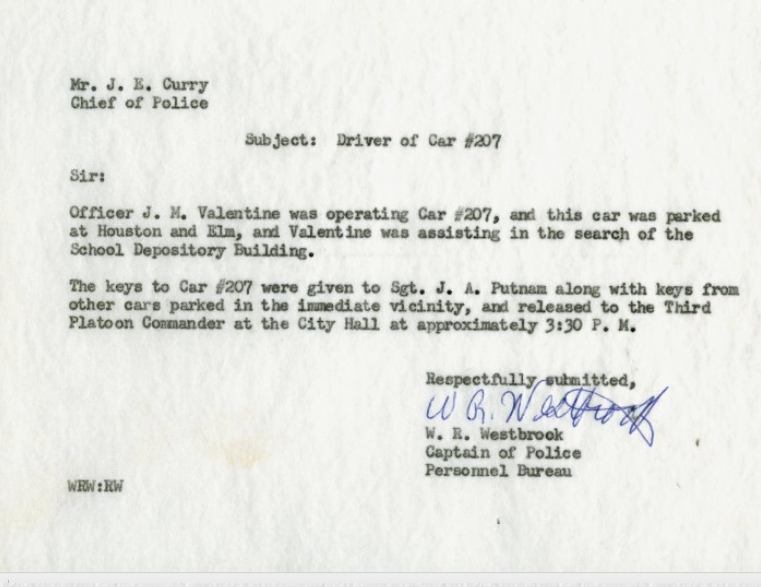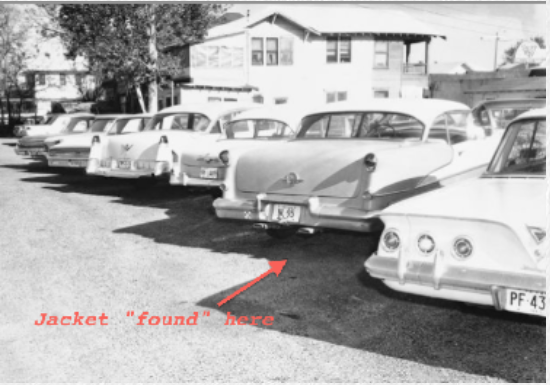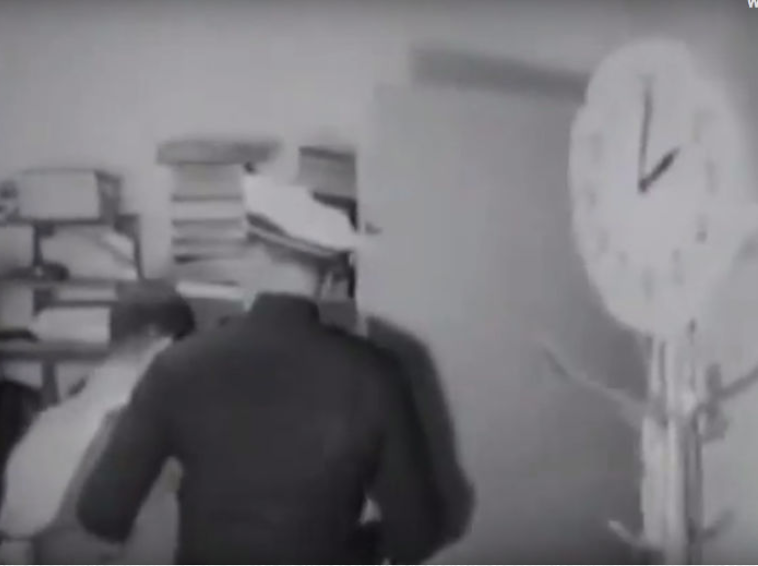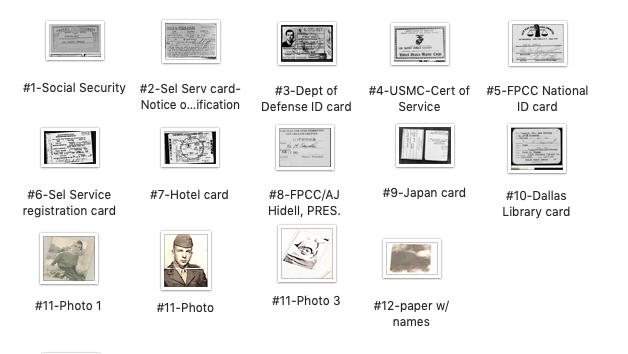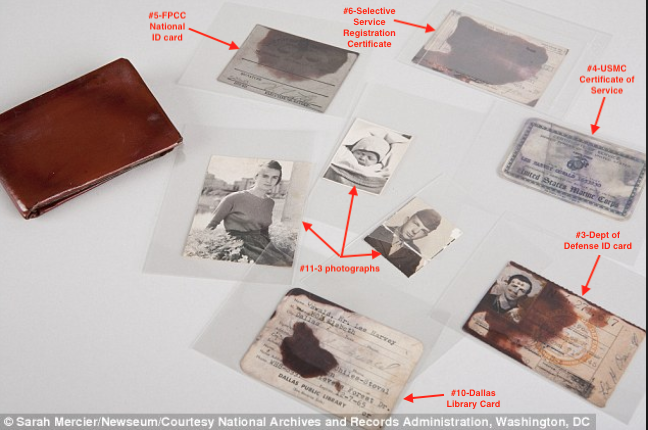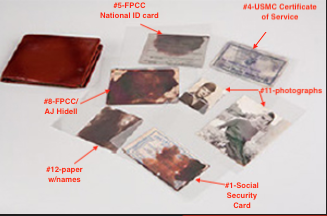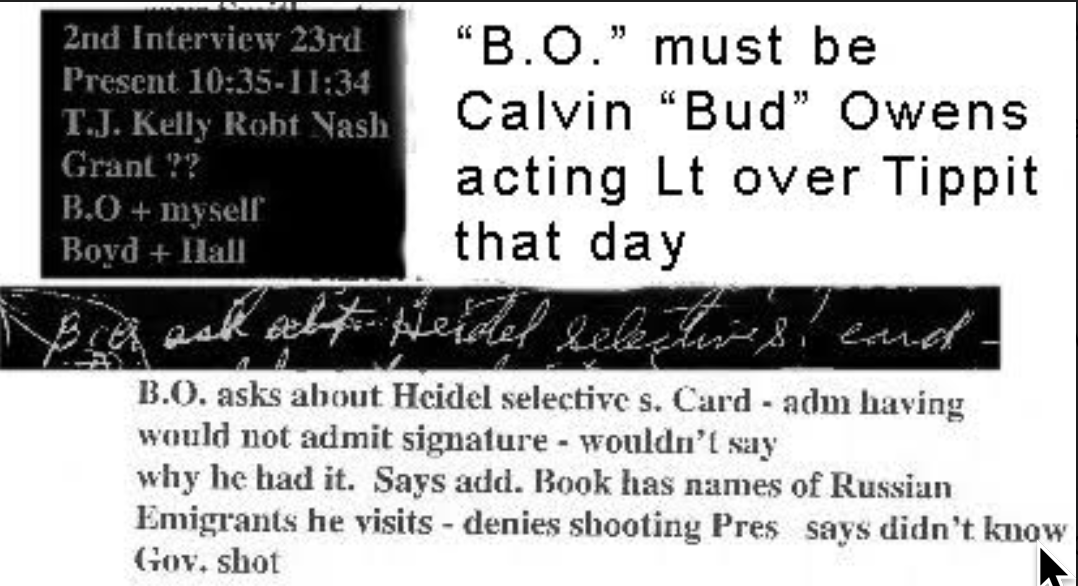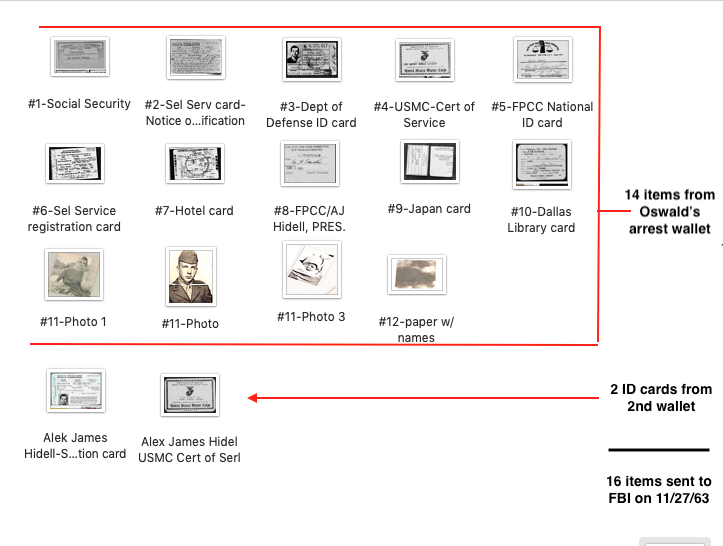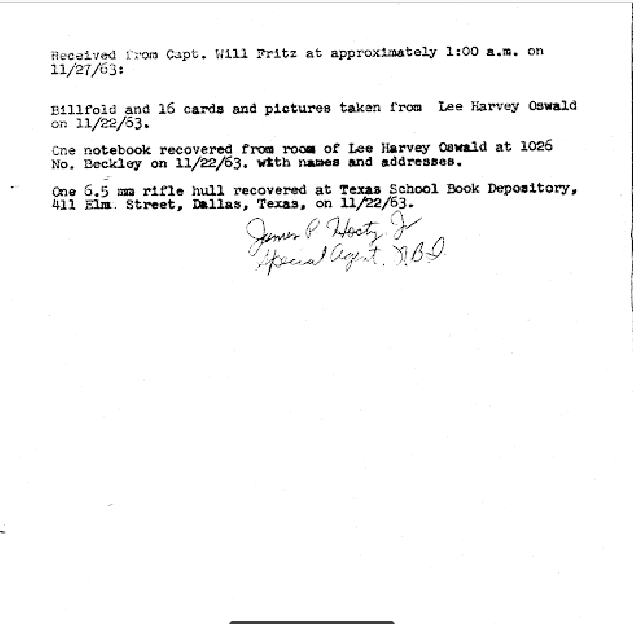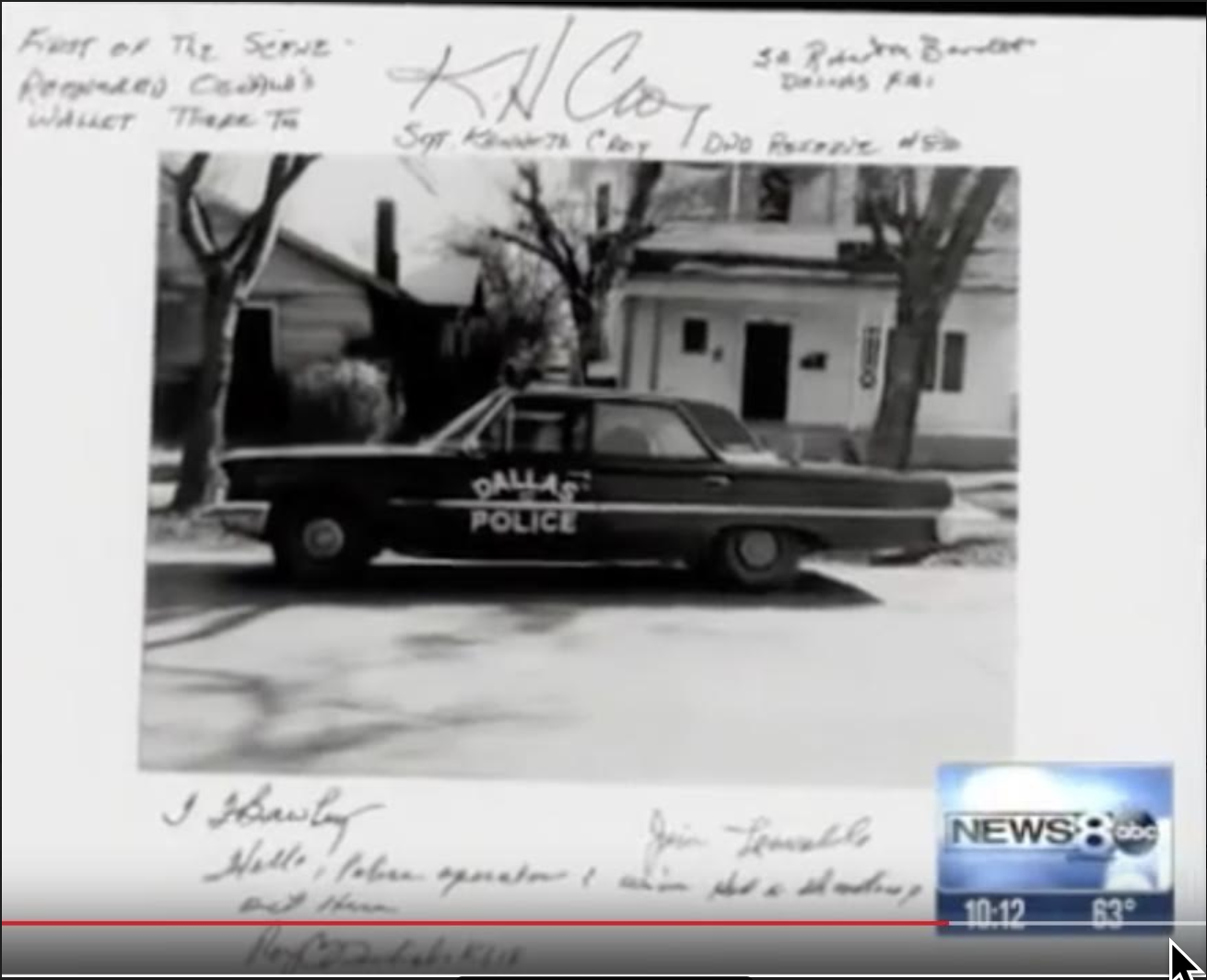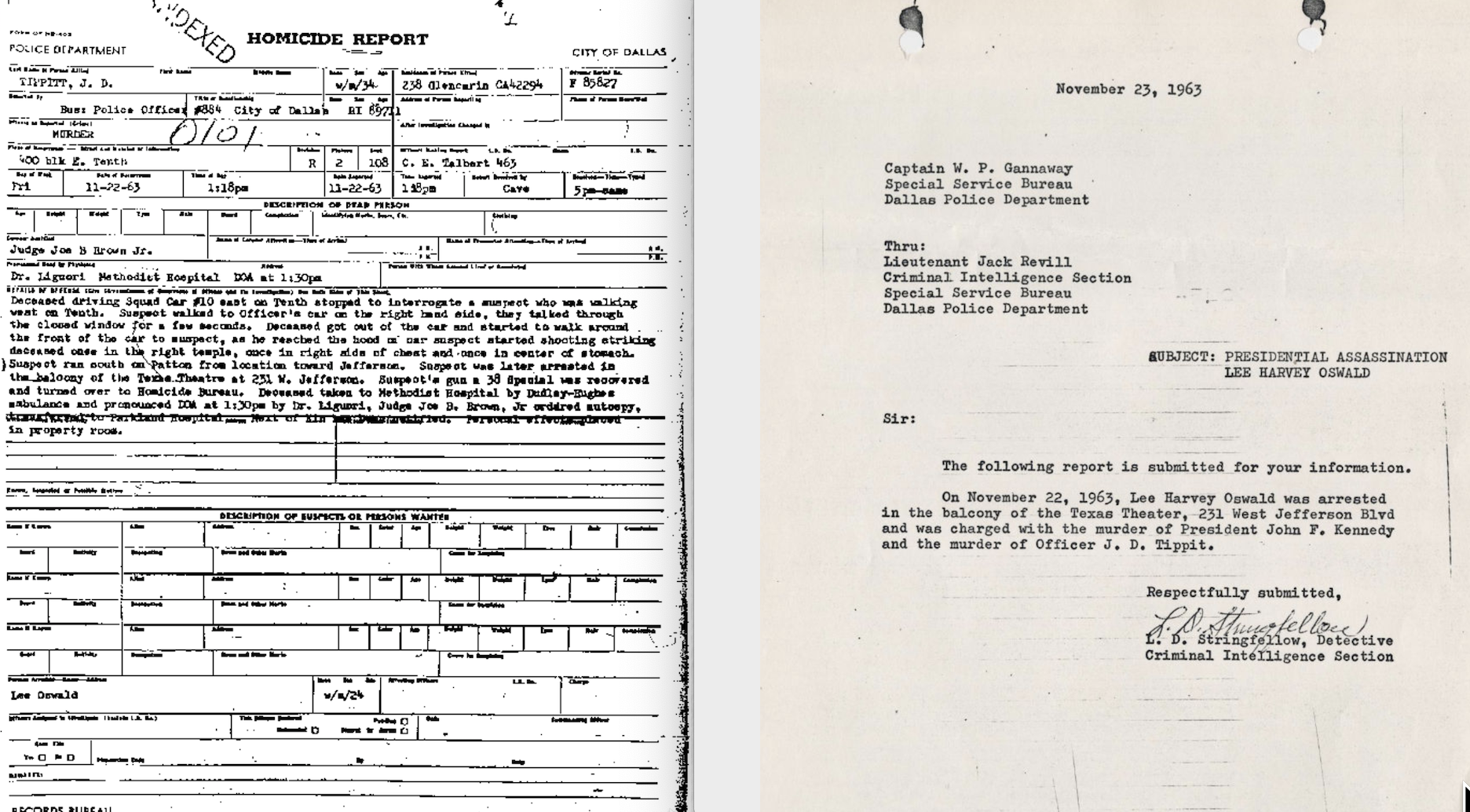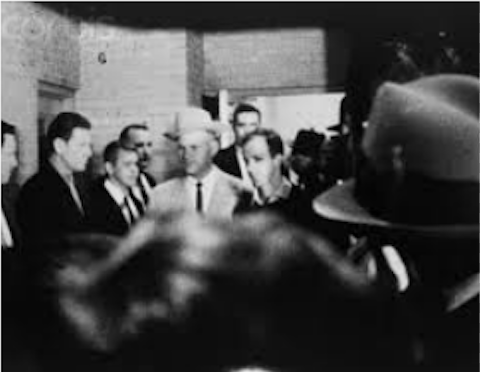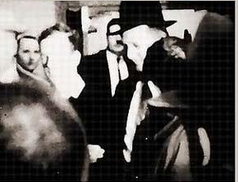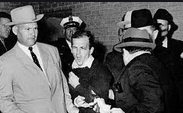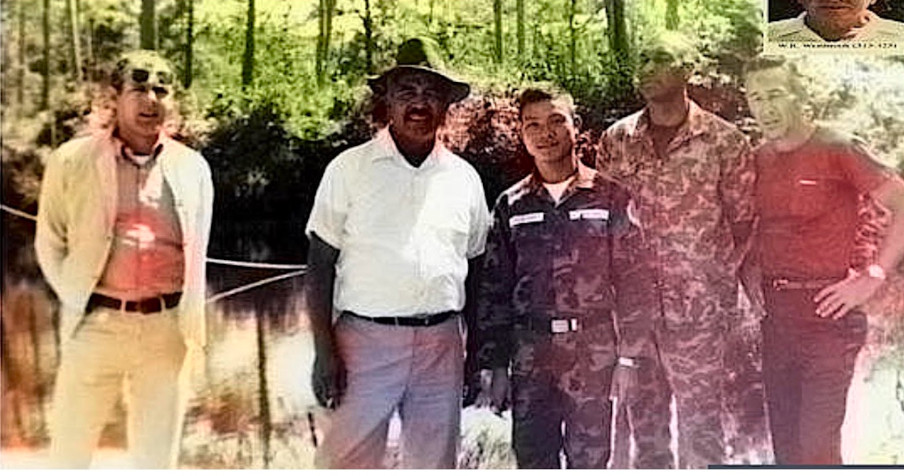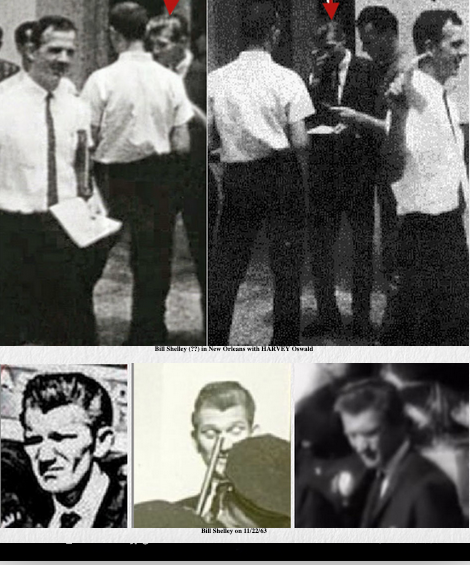![]()
What follows is a summary of my long and detailed essay on the Tippit shooting from the harveyandlee.net. website. My focus of attention is on the whereabouts and activities of Capt. William Westbrook and reserve officer Sgt. Kenneth Croy following the assassination of President Kennedy. I will focus on these men’s whereabouts and activities in 2 segments. The first segment will follow Westbrook and Croy from around 12:35 PM to about 1:20 PM—a period of only about 45 minutes, but filled with details. I hope that people who listen to this discussion will understand and realize that nearly everything that HARVEY Oswald and LEE Oswald did on 11/22/63 was pre-planned—everything—because nothing could be left to chance. HARVEY Oswald allegedly bringing a package to the Book Depository on the morning of 11/22/63 was pre-planned. Oswald working on the 6th floor of the Book Depository was pre-planned. Oswald sitting in the lunchroom when Kennedy was shot was pre-planned. Oswald quickly leaving the Book Depository was pre-planned. Oswald boarding the Marsalis bus was pre-planned. Oswald going to the Texas Theater was pre-planned. The murder of Officer Tippit was pre-planned. Nearly all of HARVEY Oswald’s movements and whereabouts on November 22 were pre-planned, but HARVEY Oswald knew nothing of these plan—but Oswald was very good at following orders. When Oswald was sent to Russia he soon learned that he would not be allowed to stay in the Soviet Union. What did he do? He cut his wrist in an attempted suicide, to demonstrate his intention to stay in the Soviet Union and complete his assignment. He was allowed to stay, given a job, and an apartment in Minsk. On the morning of November 22, I believe Oswald was following instructions/orders given to him by Bill Shelley, his contact and supervisor at the Book Depository.
Westbrook and Croy
by John Armstrong
In 1963 Capt. William Westbrook was 45 years old and in charge of the Personnel Dept. for the Dallas police. He had his own office, worked at a desk, dressed in civilian clothes and, as director of personnel, personally knew or should have known the name of every Dallas Police officer. Westbrook had nothing to do with Capt. Will Fritz's homicide and robbery division, yet following the shooting of President Kennedy Westbrook was everywhere. I believe it was Westbrook who boarded the Marsalis bus moments after Oswald got off the bus. He was likely one of the two police officers who drove past Oswald's rooming house at 1:00 PM. He was the first police officer at the parking lot behind the Texaco Station in Oak Cliff. He was at 10th & Patton showing identification for Oswald and Hidell to fellow police officers and to FBI agent Bob Barrett. He was the first police officer to arrive at the Texas Theater. He was standing close to HARVEY Oswald when Oswald was arrested. And Capt. Westbrook had possession of 4 of the most important items of physical evidence. Capt. Westbrook, wearing civilian clothes, was the highest ranking police officer at all of the previously mentioned locations, yet his job as personnel officer had nothing whatsoever to do with Homicide and Robbery.
Sgt. Kenneth Croy was 26 years old and working part time as an unpaid reserve officer with the Dallas Police. On November 22 Croy was separated from his wife and living with his parents.
The day before the assassination, on Thursday evening, November 21, HARVEY Oswald went to Ruth Paine's home in Irving, TX allegedly to visit his wife and children. However, the real purpose of his visit was probably to pick up and open a package that the conspirators mailed to him at the Paine's home. But this package was not delivered to the Paine's because of insufficient postage. The package was held at the Irving post office and, after the assassination, was opened by US Postal Inspectors.
The contained a long brown paper bag, similar in size and appearance to the paper bag allegedly used to carry the rifle into the TSBD. If Oswald had received and opened this package, he would have followed instructions and probably put his lunch in this long bag. He would then have carried this long bag into the Book Depository on the morning of November 22. This bag, with Oswald’s fingerprints, would then have been placed on the 6th floor of the Book Depository and identified as the long bag that Oswald used to carry the rifle into the building.
I do not believe that early on the morning of 11/22/63, when HARVEY Oswald left the Paine home, he knew anything about the upcoming assassination of President Kennedy. Oswald left the Paine's home carrying his lunch in a medium-size paper bag, and walked to the nearby home of Wesley Frazier, with whom he rode to the Book Depository. Wesley Frazier's sister, Linnie Mae Randle, watched Oswald as he walked to her house and told the WC that Oswald was wearing a grey jacket with big sleeves. Mrs. Randle identified the jacket described as CE 163, a somewhat heavy dark grey/blue work jacket. It is important to follow the whereabouts and final location of this jacket.
When Oswald walked into Book Depository he was carrying a medium size brown paper bag which contained his lunch. Bill Shelley, Oswald’s supervisor, would later tell fellow employees that he saw Oswald carrying a large paper bag when he entered the building. Bill Shelley was also the man who made sure that Oswald, and other employees, would work on the 6th floor that morning. At lunchtime, I believe it was Bill Shelley who told Oswald to remain in the lunchroom as President Kennedy’s limousine drove past the front of the building.
On November 22, around 12:31 PM, one of the Dallas Police Department dispatchers, Mrs. Kinney, came into Westbrook's office and told him that shots had been fired at President Kennedy. Westbrook told the WC that he sent police officers from his personnel office to the Texas School Book Depository. Westbrook told the WC there wasn't a police car available to drive him to the Book Depository, so he walked to the building. This was the first of many lies that Westbrook would tell the WC, because WESTBROOK did not walk 1 mile to the Book Depository. He drove his own dark blue, unmarked police car to the Book Depository. There were, in fact, several police cars available at the police station at 12:30 PM. These cars would soon take police officers, detectives, and people from the crime lab to the scene of the shooting. One of those police cars, squad car #207, was in the basement and was assigned to Officer Jimmy Valentine. Valentine soon drove Officer Gerry Hill, from Westbrook’s personnel office, and Dallas Morning News reporter Jim Ewell to the Book Depository. Ewell said the drive took about two minutes and they arrived at the Book Depository about 15 minutes after the shooting.
arrive at the Book Depository circa 1:45 PM
Ewell said, “This officer (Jimmy Valentine) drove us back from east to west through downtown on the most circuitous route I can recall, and we were back there at the School Book Depository probably in less than two minutes…. We found ourselves standing right out in the middle of the intersection of Houston and Elm. I’m going to say this was probably inside of fifteen minutes from the time that I had seen the swarm of people near the Triple Underpass and heard on the radio that shots had been fired. It happened that quickly. A few minutes later Ewell left Dealey Plaza. He said, "I left the location at the School Book Depository and jumped into a car driven by Captain Westbrook with Sargeant Stringer. I rode in the back seat as we sped across into Oak Cliff by taking the Houston Street Viaduct right beside the Dallas News.”
Westbrook told the WC that he "sat around" for a while and then began walking, in civilian clothes, one mile to the Texas Book Depository Building--a 22 minute walk. But Westbrook did not walk to the Book Depository. He drove his own police car to the Book Depository as can be seen from his testimony. Westbrook told the WC, "After WE reached the building I contacted my sergeant [notice that Westbrook said WE, PLURAL, yet he just told the WC that he walked by himself to the Book Depository]. Westbrook said, "Sgt. Stringer was standing in front and so then I went into the building to help start the search." Westbrook said that he went into the building to START THE SEARCH, BUT POLICE HAD ALREADY BEEN SEARCHING THE BOOK DEPOSITORY. Westbrook then told the WC, "I was on the first floor and I had walked down an aisle and opened a door onto an outside loading dock. And when I came out onto this dock, one of the men hollered and said there had been an officer killed in Oak Cliff." Westbrook's own testimony places him at the Book Depository at or around 1:15 PM--45 minutes after the shooting.
WESTBROOK'S WARREN COMMISSION TESTIMONY ASIDE, HIS WHEREABOUTS FROM THE TIME HE WAS LAST SEEN AT THE POLICE STATION (CIRCA 12:35 PM) TO HIS ARRIVAL AT THE BOOK DEPOSITORY ARE UNKNOWN. WESTBROOK’S STORY OF WALKING ALONE TO THE BOOK DEPOSITORY, AFTER THE PRESIDENT OF THE UNITED STATES WAS SHOT, IS NEARLY IMPOSSIBLE TO BELIEVE, AND THERE IS NO PROOF AND NOT A SINGLE WITNESS WHO SAW WESTBROOK WALKING TO THE BOOK DEPOSITORY. BUT WESTBROOK'S STORY OF WALKING TO THE BOOK DEPOSITORY, WHICH I BELIEVE IS A TOTAL LIE, GAVE HIM AN ALIBI TO ACCOUNT FOR 40-50 MINUTES OF HIS TIME.
Reserve officer Sgt. Kenneth Croy told the WC that when President Kennedy was shot, at 12:30 PM, he was “sitting in his car at the city hall”—police headquarters. Now, I would like to stop a minute and ask listeners a question….There were thousands of people lining the streets of Dallas to see the Presidential parade. Police officers were everywhere, yet Croy wants us to believe that he was sitting in his car at police headquarters at the time of the shooting. Why was Croy sitting in his car?
Croy told the WC that after shots were fired at President Kennedy he left the police station and began to drive home. Croy said that he was "hemmed in from both sides" by traffic on Main and Griffin for about 20 minutes. He then drove past the courthouse on Elm and asked police officers, whose names he did not know, if he could be of any assistance. Croy said that after the officers said "No" that he proceeded to drive home. Croy would have us believe that after shots were fired at the President, he left the police station and was told by unknown officers that his services were not needed, when many off-duty police officers were called at home and told to report for duty. Croy testified that while talking with the police officers in front of the courthouse his estranged wife "pulled up beside me" in her car. Croy said they began talking and then decided to go to lunch together at Austin's Barbecue, even though Croy and his wife were separated. But first, Croy said, he needed to change clothes at his parents' home. On the day of President Kennedy's assassination Croy would like us to believe that his priorities were to drive to his parents' house, change clothes, and then have lunch with his estranged wife!!
I do not believe Croy was hemmed in by traffic for 20 minutes. Remember that news reporter Jim Ewell said the drive from police headquarters to Dealey Plaza took less than 2 minutes, arriving less than 15 minutes after the shooting. I do not believe Croy spoke with police officers in front of the courthouse, nor do I believe that Croy talked with his wife about having lunch at Austin’s Barbecue. I believe that minutes after the assassination Croy was sitting in his car at police headquarters, he met up with Capt. Westbrook, and he rode in Westbrook’s dark blue, unmarked police car to the Book Depository.
CROY TOLD THE WC THAT “HE WAS SITTING IN HIS CAR AT THE CITY HALL” WHEN SHOTS WERE FIRED AT PRESIDENT KENNEDY. I BELIEVE THAT CROY WAS, IN FACT, SITTING IN HIS CAR. BUT CROY WAS SITTING IN HIS CAR WAITING FOR CAPT. WESTBROOK TO COME DOWN FROM HIS OFFICE ON THE 3RD FLOOR. WESTBROOK WOULD THEN DRIVE HIS DARK BLUE, UNMARKED POLICE CAR, ALONG WITH CROY, FROM THE POLICE STATION TO THE BOOK DEPOSITORY. CROY’S WHEREABOUTS, LIKE CAPT. WESTBROOK’S, ARE UNKNOWN FROM 12:30 PM UNTIL 1:10 PM. CROY’S STORY ABOUT GETTING HEMMED IN WITH TRAFFIC FOR 20 MINUTES, TALKING WITH POLICE OFFICERS IN FRONT OF THE COURTHOUSE, AND DRIVING TO HIS PARENTS HOUSE TO CHANGE CLOTHES, GAVE HIM AN ALIBI TO ACCOUNT FOR NEARLY 3/4 OF AN HOUR OF HIS TIME. CROY WOULD LIKE US TO BELIEVE THAT ON THE DAY THE PRESIDENT OF THE UNITED STATES WAS KILLED, ONE OF THE MOST MEMORABLE DAYS OF THE CENTURY, CROY DECIDED TO HAVE LUNCH WITH HIS ESTRANGED WIFE AND GO HOME.
AS I SAID BEFORE, THE PURPOSE OF MY WORK TODAY IS TO DETERMINE CAPT. WESTBROOK AND RESERVE OFFICER SGT. KENNETH CROY'S LIKELY WHEREABOUTS AND THEIR ACTIVITIES FROM 12:35 THRU 1:20 PM ON THE AFTERNOON OF NOVEMBER 22, 1963. THIS 45 MINUTES OF MISSING TIME IS SHORT, LESS THAN AN HOUR, BUT THE DETAILS OF THEIR ACTIVITIES TAKE TIME TO EXPLAIN AND UNDERSTAND.
_____________________________________________________________________________________
I believe that HARVEY Oswald first learned that President Kennedy had been shot when he was confronted by Officer Marrion Baker and Roy Truly in the 2nd floor lunchroom moments after the shooting (circa 12:31-32 PM). HARVEY Oswald, obviously disturbed by the news, left the lunchroom wearing his long sleeve brown shirt to look for Bill Shelley for advice and direction. Oswald left the lunchroom and walked down the 2nd floor hallway toward Elm St., turned left onto the hallway leading to the front stairway, and hurried down to the first floor. HARVEY Oswald momentarily looked out the front glass doors, hoping to find Bill Shelley. WFAA radio program director Pierce Allman and WFAA salesman Terrance (Terry) Ford quickly entered the building and asked Oswald for the location of a telephone (circa 12:33 PM). Oswald then walked into the warehouse area and met up with Shelley near the domino room. I speculate that Shelley told HARVEY Oswald to leave the building, board the Marsalis bus on Elm St., and go directly to the Texas Theater to meet his contact. I believe that Shelley gave HARVEY Oswald half of two one dollar bills, which Oswald was told he could use to identify his contact at the Texas Theater. Oswald did board the Marsalis bus, and got a bus transfer to board a 2nd bus at the corner of Marsalis and Jefferson Blvd. which would then take him to the Texas Theater. After arriving at the theater, Oswald would look for his contact, who had the other half of the two, one dollar bills, to confirm his identity.
HARVEY Oswald picked up his grey/blue work jacket from the domino room, left the building by the rear loading dock, and began walking east on Elm St. At 12:39 PM HARVEY Oswald pounded on the door of the Marsalis bus, which was stopped in the middle of Elm St., headed toward the Book Depository. He boarded the bus, paid his fare, got a bus transfer, and took a seat. The bus was soon stalled in traffic and, 4-5 minutes later, Oswald decided to get off the bus (circa 12:44 PM). Oswald getting off the bus was the only thing he did that afternoon that was not according to carefully arranged plans by the conspirators. Bus passenger Roy Milton Jones told the FBI that shortly after a man (HARVEY Oswald) got off the bus, two police officers boarded the bus and searched passengers for weapons, around 12:47 to 12:50 PM. Why would police board a bus on Elm St. that was headed toward the Book Depository? Because Oswald was supposed to be on this bus. The presence of two police officers boarding the Marsalis bus was not discussed nor investigated by the Warren Commission nor by the FBI nor the Dallas Police.
I believe that Capt. Westbrook, and his fellow conspirators, knew that HARVEY Oswald would board the Marsalis bus, ride the bus to Oak Cliff, and then transfer to another bus that would take him to the Texas Theater. After crossing the Trinity River bridge the Marsalis bus would turn left at the corner of Marsalis and Zang—directly across the street from the Gloco Station where Officer Tippit was waiting in his patrol car. When the bus turned left, Tippit would follow the bus to Jefferson Blvd., probably to make sure that Oswald boarded a 2nd bus and arrived at the Texas Theater. But two things happened—#1) Oswald got off of the Marsalis bus on Elm St. when it was stalled in traffic, before the two police officers boarded the bus. I believe that Westbrook and Croy were the two police officers who boarded the Marsalis Ave bus (stopped near Elm and Houston) intending to locate and perhaps murder HARVEY Oswald. After learning that HARVEY Oswald was not on the Marsalis bus, I believe that Westbrook knew that he needed to find Oswald, and quickly. But Westbrook knew better than to drive his unmarked, dark blue police car to look for Oswald in Oak Cliff. Instead, Westbrook and Croy got into Dallas police car #207, which had just arrived at the Book Depository, and quickly drove to Oak Cliff (circa 12:50 PM) in an attempt to locate HARVEY Oswald.
As Westbrook and Croy began to drive toward Oak Cliff in car #207 the Marsalis bus turned left from Zang onto Marsalis. Tippit left the Gloco Station and began following the bus. At 12:54 PM Tippit reported his position to the police dispatcher as “Lancaster and 8th,” one block south of Marsalis St. and very close to Jefferson Blvd. Tippit could see the Marsalis bus when it stopped at Jefferson Blvd, but Oswald did not get off the bus !! Tippit was momentarily confused and needed direction, because Oswald had disappeared !!. Tippit turned right onto Jefferson Blvd, and drove to the Top 10 Record Store. Store clerk Louis Cortinas saw Tippit enter the store, asked people to move aside, grabbed the store telephone, called someone at 12:58 PM but did not get an answer, and then quickly left the store. No doubt Tippit was trying to contact Westbrook. Tippit then drove to 404 E. 10th St for his pre-arranged meeting with Capt. Westbrook at 1:00 PM. Tippit arrived a few minutes late, around 1:05 PM, and parked his squad car directly in front of the long, narrow driveway between 404 and 408 E. 10th St. Tippit was now able to see Capt. Westbrook when he arrived and drove his car from the alley onto the driveway facing Tippit’s car.
HARVEY Oswald quickly leaving the Book Depository and boarding the Marsalis Ave. bus was pre-planned. It was designed to make it appear as though Oswald was trying to quickly “escape” from the scene of the shooting. Only minutes after HARVEY Oswald left the building Bill Shelley told building supervisor Roy Truly that Oswald was missing. Oswald’s “pre-planned get-away,” aboard the Marsalis bus, explains how Stuart L. Reed, a civilian employee of the US Army, knew to be in a position on Elm St so that he could photograph the front of the Marsalis bus within minutes of Oswald boarding the bus. A few minutes later Reed took a photograph of the back of the Marsalis bus, within minutes of the two policemen boarding the bus. If HARVEY Oswald had been on the bus when the two policemen boarded the bus, he would likely have been killed. There is no innocent explanation as to why Stuart Reed, or anyone, would take photographs of the front and back of a city bus unless Reed, or someone close to him, knew that Oswald would be on the Marsalis bus minutes after the shooting.
If Oswald had been on the Marsalis bus, Reed’s photographs would have captured the moment during which the assassin of President Kennedy was either captured or killed while trying to escape. After photographing the Marsalis bus, Stuart Reed took a photo of the Book Depository and an hour later was in Oak Cliff photographing Oswald’s arrest at the Texas Theater. How did Reed know to take photos of the Marsalis bus, the Book Depository and travel to Oak Cliff to take photos of Oswald’s arrest at the Texas Theater? Only if Reed, or someone directing Reed, had prior knowledge of HARVEY Oswald’s pre-planned movements following the assassination. On November 22, Reed was working for the US Army in the Panama Canal Zone; he was not in Dealey Plaza to take photographs of the President's motorcade. He was in Dallas to take photographs of HARVEY Oswald’s escape from the Book Depository. Before returning to Panama, Reed left his film to be developed, with instructions to give the prints to the FBI.
After getting off the Marsalis bus on Elm St., HARVEY Oswald walked to the Greyhound bus station and got into a taxi driven by William Whaley, circa 12:48 PM. Whaley told the WC, "He was walking south on Lamar from Commerce when I saw him.... He was dressed in just ordinary work clothes. It wasn't khaki pants but they were khaki material, blue faded blue color, like a blue uniform made in khaki. Then he had on a brown shirt with a little silverlike stripe on it and he had on some kind of jacket, I didn't notice very close but I think it was a work jacket that almost matched the pants." HARVEY Oswald was wearing the same grey/blue colored jacket that Ellie Mae Randle saw him wearing when he arrived at the Frazier’s house in Irving. Near Oswald’s rooming house he got out of Whaley’s taxi (circa 12:54 PM), took off his grey/blue work jacket, and walked to his rooming house carrying his grey/blue work jacket, arriving circa 1:00 PM.
Moments after Oswald arrived housekeeper Earlene Roberts heard a car honk the horn and looked out the window. She saw two men, in police car #207, as they drove slowly past Oswald's rooming house. I have little doubt these two men were Westbrook and Croy, looking for HARVEY Oswald. Earlene Roberts testified that when Oswald (HARVEY) left the rooming house (circa 1:01-1:02) he was wearing "a kind of zipper jacket" and described the jacket as being "dark color." I believe that Oswald (HARVEY) was wearing the same dark grey/blue jacket seen by Lillie Mae Randle, the same jacket he picked up from the domino room before he left the Book Depository, and the same jacket seen by taxi driver Whaley. Earlene Roberts last saw Oswald standing near the corner of Beckley and Zang.
According to Butch Burroughs, who worked at the Texas Theater, Oswald arrived between 1:01 and 1:07 PM. Therefore, Oswald could not possibly have walked from his rooming house to the theater. I believe Westbrook and Croy picked up HARVEY Oswald and drove him to the alley behind the Texas Theater, arriving circa 1:03 PM. Oswald walked from the alley thru a narrow passage to Jefferson Blvd. This passage way was used in 1963 and is still used today as a fire escape from the theater.
Oswald then turned right, walked to the ticket booth and purchased a theater ticket from Julia Postal (circa 1:05 PM). HARVEY Oswald entered the theater wearing a long sleeve brown shirt. He apparently left his grey/blue work jacket in police car #207. Oswald purchased popcorn 10 minutes later, at 1:15 PM, before the movie started, and took a seat next to a pregnant woman. Within a few minutes both Oswald and the woman got up from their seats—the woman disappeared and was never seen again. Who was this woman? Why would a pregnant woman buy a ticket for a war movie at 1:00 in the afternoon, and then disappear before the movie began? Oswald then walked into the concession area and then back into the lower level and took a seat next to Jack Davis as the opening credits to the movie began--a few minutes before 1:20 PM. A few minutes later Oswald got up and walked past empty seats to the small aisle on the right side of the theater and into the concession area. Davis watched HARVEY Oswald as he re-entered the theater and took a seat next to a man on the back row, directly across the aisle from Davis. Within a few minutes HARVEY Oswald got up and once again returned to the concession area. He returned a few minutes later and took a seat across the aisle from Mr. Davis, and then moved to another seat on the fourth row. It appeared to Davis as though HARVEY Oswald was looking for someone, perhaps a contact. Davis was correct. HARVEY Oswald was looking for his contact.
With HARVEY Oswald in the theater, Westbrook and Croy left the alley and drove 6 blocks east, thru the alley between Jefferson Blvd and 10th St. Westbrook then turned squad car #207 onto the narrow driveway between two houses at 404 and 410 E. 10th. He parked car #207 between the two houses, where the car was mostly hidden from view of neighbors. Westbrook and Croy arrived about 1:05 PM, and momentarily saw LEE Oswald talking with Tippit thru the passenger side car window. Tippit, meeting up with LEE Oswald and Capt Westbrook shortly after 1:00 PM, at a driveway between 404 and 410 E. 10th was no accident. Their meeting was pre-planned.
J.D. Tippit lived with his wife and family at 238 Glencairn, 7 miles south of 10th & Patton, and patrolled area 78 in South Oak Cliff, far away from 10th & Patton. Curiously, several of the people who witnessed the shooting of Officer Tippit near 10th & Patton either knew him or were familiar with him, even though he was many miles from his assigned patrol area. Jimmy Burt, a witness to the Tippit shooting, knew Tippit "as an officer who frequented the neighborhood." Burt said, "This particular officer was known by the name 'Friendly' to the residents of that area." Taxi Driver William Scoggins said, "I wasn't paying too much attention to the man, you see, just used to see him every day." Witness Aquila Clemmons, who lived at the home of Mr. & Mrs. Smathers at 327 E. 10th, told researcher Mark Lane that she saw Tippit "all the time." Five witnesses at the nearby GLOCO station said they knew Tippit personally, yet the area around 10th & Patton was several miles from his assigned patrol district. Tippit's familiarity with numerous local residents could be explained and understood by the Warren Commission testimony of Virginia Davis, who lived at 400 E. 10th, two houses west of the house where Tippit was shot and killed. Davis was asked by Commission attorney David Belin "Where was the police car parked?" Davis answered, and her answer is very important, "It was parked between the hedge that marks the apartment house where he (Tippit) lives in (410 E. 10th) and the house next door (404 E. 10th)." According to Virginia Davis, Officer Tippit was living in the house at 410 E. 10th, two houses east of her house. This house is actually a duplex apartment, with 410 E. 10th in the front and 408 E. 10th in the rear of the house. If Tippit was having an affair with a woman living in this house, this would explain not only his familiarity with local residents, but could also explain a familiar location where he could meet up with LEE Oswald and Capt. Westbrook.
When Tippit saw Westbrook arrive in the squad car, for their pre-arranged meeting at 1:00 PM, Tippit got out of his patrol car to meet with Westbrook. As Tippit was walking to the front of his patrol car, he was shot and killed by LEE Oswald. Domingo Benavides, driving his yellow Chevrolet truck west on 10th St., slammed on his brakes and turned his truck to the curb. Benavides was only 20 feet from Tippit’s squad car and clearly saw the man who shot Tippit. A neighbor (Mrs. Doris Holan), and likely Domingo Benavides, saw a man (who I think was Westbrook) get out of a police car and hurry toward Tippit who was dying and laying next to his squad car. Benavides, sitting in his truck, saw the shooter as he left the scene, and likely saw the unidentified man (Westbrook) as he returned to the squad car parked between the two houses.
Westbrook was well aware that Benavides was the one person who could see his police car and link the Dallas Police to the murder of Officer Tippit. This could explain why Domingo Benavides’ brother, who was probably mistaken for Domingo, was shot and killed two months later. Benavides dared not report that two Dallas police officers were on site and involved with the Tippit shooting.
Mrs. Holan watched as the man from the police car briefly looked at Tippit, lying in the street, and then returned to the police car and backed the car into the alley. Sam Guinyard, an employee of Harris Motors, saw a police car driving in the alley moments after the shooting. I believe that Guinyard saw police car #207, with Westbrook driving, while Croy remained at the scene of the shooting. I also believe that Croy temporarily wore HARVEY Oswald’s grey/blue jacket, in an attempt to cover the upper portion of his police uniform.
Virginia Davis and her sister, Barbara Davis, lived in the house at the corner of 10th & Patton. Virginia told the WC, “We saw the boy cutting across the street….After he disappeared around the corner we ran out in the front yard and down to see what had happened….I saw the policeman lying on the street.” WC attorney Belin then asked, “did police come out there?” Virginia Davis said, “Yes; they was already there.” Belin asked, “By the time you got out there?” Virginia Davis answered, “Yes, sir.” Virginia Davis told the Warren Commission that after the shooter (LEE Oswald) ran around the corner of her house a policeman "was already there." I believe this policeman was reserve officer Sgt. Croy, who remained at the scene after Westbrook backed up into the alley and left the scene.
Sgt. Croy had to be very careful. If witnesses saw Croy, in uniform, only moments after Tippit was shot, then he would be considered a suspect in the shooting. I believe that after getting out of the police car, Croy put on the dark colored jacket that HARVEY Oswald left in Westbrook's car. Wearing this jacket would cover the upper portion of his police uniform, and help to conceal his identity as a police officer. After the shooting witness Helen Markham hurried over to Officer Tippit, lying next to his car on the pavement. She told the Warren Commission that very soon an unknown man was standing beside her…Helen Markham said, "He had a hat on. I thought he was a policeman." The only policeman at the scene of the Tippit shooting, before the ambulance arrived within a few minutes, was Croy.
As a reserve officer Croy was not allowed to carry a gun. The dark colored jacket and lack of a gun may have caused Helen Markham to wonder if this man was, in fact, a policeman. I believe that moments before the ambulance arrived Croy removed the grey/blue jacket and placed the jacket on Tippit’s body.
When the ambulance arrived a few minutes later, at 1:09-1:10 PM, the driver, Jasper Clayton Butler, told the HSCA that he removed a “royal blue coat from Tippit’s body.” Butler did not see who picked up the jacket. I believe this was the coat worn by HARVEY Oswald on the morning of November 22, the coat seen by taxi driver William Whaley, the coat Oswald was wearing when he left his rooming house, the coat left in police car #207, and the coat briefly worn by Croy. If Croy was not the man who placed a jacket on Tippit’s body, then who did??—witnesses Bowley, Callaway, Benavides, Burt, Scoggins? Three weeks later, on December 16, this dark grey/blue coat was “found” on the windowsill in the domino room of the Book Depository by employee Frankie Kaiser. How did this coat, worn by Oswald when he left the rooming house, get from the Tippit murder scene to the Book Depository? Croy to Westbrook to Bill Shelley to the domino room.
After helping load Tippit's body into the ambulance, T.F. Bowley said that he talked with a police sergeant (almost certainly Sgt. Croy) at the scene and then left. Croy interviewed Helen Markham for the next 5-10 minutes and then turned her over to police officers when they arrived on the scene. It is very important to remember that Croy, the first policeman on the scene, the policeman who watched Tippit's body loaded into the ambulance, the policeman who talked with Helen Markham for 5-10 minutes, never filed a police report about his presence at the Tippit murder scene.
Croy tried to explain his early arrival at the Tippit murder scene to the Warren Commission, but there was an unexplained time problem. Croy said that he was at the intersection of Colorado Blvd. and Zang, driving his personal car and listening to his police radio, when he heard the dispatcher broadcast the shooting of Tippit. The first report of the Tippit shooting occurred circa 1:08 PM, only a minute or two before the ambulance arrived at 1:09-1:10 PM. Croy told the WC that he saw Tippit’s body loaded into the ambulance. But Croy could not have been at Colorado Blvd and Zang at 1:08 PM and seen Tippit’s body loaded into the ambulance 1-2 minutes later. The time required to drive from Colorado Blvd and Zang to 10th & Patton is 5-6 minutes, and the police dispatcher gave 4 different addresses on Jefferson Blvd. and 10th Street. How would Croy know to drive directly to 10th & Patton? If Croy had arrived at 10th & Patton in his personal car, in uniform, he would have been approached by many witnesses as soon as he got out of his car. But this did not happen, because Croy did not drive to 10th & Patton, and there are no reports by any witness that a police officer arrived on the scene in his personal car. Why was Croy’s car never seen at or near 10th & Patton? Because Croy did not drive to 10th & Patton. Croy arrived at the scene of the Tippit murder with Capt. Westbrook in police car #207. Croy did not file a report advising that he was the first police officer on the scene,or advising that he found a wallet, or that he gave that wallet to Sgt. Owens or to Westbrook, or describing his interview with Helen Markham, his observation of Tippit lying near his police car, or of Tippit being loaded into an ambulance. Croy, like Westbrook, lied to the WC and did his best to conceal his activities on the afternoon of November 22.
After leaving the scene of the Tippit shooting, LEE Oswald was seen by several witnesses as he walked around the corner of the Davis's house, walked south on Patton St., and turned right on the north side of Jefferson Blvd. Warren Reynolds watched the shooter as he began walking west on the north side of Jefferson Blvd. Reynolds began following Oswald (LEE), but Reynolds was on the south side of Jefferson Blvd. while LEE Oswald was across the street walking on the north side of Jefferson Blvd. Reynolds watched as Oswald hurried past the Texaco station and then began walking north thru a parking lot behind the station. Reynolds crossed Jefferson Blvd and began walking thru the car lot but lost sight of the shooter. I believe, and please understand there is no definitive proof, that after Tippit was shot Capt. Westbrook quickly backed up police car #207 into the alley and drove one block west to Crawford St., where he soon met up with LEE Oswald near the Abundant Life Church.
At first it may seem bizzare to think that LEE Oswald, after murdering Tippit, would get into a police car driven by Capt. Westbrook. Minutes after Tippit was killed the police were hunting for the suspect, who was last seen walking west on Jefferson Blvd. If LEE Oswald had been stopped and arrested by police anywhere between 10th and Patton and the Tecxas theater, the whole carefully planned operation to blame HARVEY Oswald for the murder of President Kennedy and Officer Tippit would have been compromised. HARVEY Oswald, sitting quietly in the theater as Officer Tippit was murdered, could not be blamed for killing Tippit nor blamed for killing President Kennedy. Therefore, it was absolutely essential that LEE Oswald arrive quickly and safely at the Texas Theater. And who could drive LEE Oswald to the theater without fear of being stopped by police? Captain Westbrook, who I believe drove from the Abundant Life Church, through the alleyway between Jefferson Blvd. and 10th St., and dropped LEE Oswald off in the alley behind the Texas Theater. LEE Oswald then walked thru a narrow walkway from the alley to Jefferson Blvd, and quietly bought a theater ticket from Julia Postal. LEE Oswald then hurried up the stairs to the balcony while Harvey Oswald was sitting in the lower section.
As LEE Oswald was walking west on Jefferson Blvd, and thru the parking lot behind the Texaco station, he may have realized that someone was following him. It was Warren Reynolds who was following him. When LEE Oswald met up with Capt. Westbrook, and got into police car #207, he probably told Westbrook that someone was following him. To Capt. Westbrook this individual posed a very serious threat. It didn't matter whether Reynolds actually saw the shooter (LEE Oswald) get into a police car. It only mattered if Capt. Westbrook thought he did, because Warren Reynolds could then connect the man who shot Tippit with the Dallas Police. For Westbrook this was potentially a very serious problem. Westbrook soon learned the identity of Warren Reynolds by reading police reports of interviews with witnesses. Once Westbrook had identified the troublesome witness as Warren Reynolds, the threat that Reynolds posed could be handled. This may have been the reason Reynolds was shot in the head two months later.
On January 22, 1964, FBI agents Kesler and Mitchem showed a photograph of Lee HARVEY Oswald to Reynolds, who advised the two agents that he would hesitate to identify the man shown in the photograph as the shooter. The following day, at 9:00 PM in the evening, Reynolds was shot in the head with a .22 caliber rifle. The prime suspect was Darrell Wayne Garner and he was arrested. Betty (Mooney) MacDonald, a former stripper at Jack Ruby's Carousel Club, provided an alibi for Garner and he was released. Two weeks later, on February 13, 1964, Betty MacDonald was arrested for disturbing the peace. The next morning she was found dead, hanging from the ceiling in the jail cell with her toreador trousers. Warren Reynolds, after being shot in the head, changed his mind and identified HARVEY Oswald as the shooter.
During the short drive to the Texas Theater, I believe that LEE Oswald gave Westbrook his wallet, his light colored Eisenower type jacket, and the .38 revolver used to kill Tippit. LEE Oswald, now without identification, without a jacket, and without a gun, bought a movie ticket from Julia Postal, entered the lobby, and hurried up the stairs to the balcony. The opening credits to movie were playing (circa 1:12 PM) and Butch Burroughs, the ticket-taker and concessionaire, was likely working at the concession stand and could not see LEE Oswald enter the lobby or hurry up the stairs.
Westbrook quickly drove police car #207 back to the Texas School Book Depository, arriving circa 1:18-1:20 PM. In 45 minutes Westbrook had driven car #207 from the Book Depository to Oswald’s rooming house, then to the Texas Theater, then to 10th & Patton, once again to the Texas Theater, and returned to the Book Depository circa 1:20 PM. Westbrook now had to account for his whereabouts during that time, and this is why Westbrook told the WC that he walked from the police station to the Book Depository. When Westbrook returned to the Book Depository it was very important for him to be seen by fellow police officers when reports of the Tippit shooting were broadcast by the police dispatcher.
When Westbrook was interviewed by the WC, he lied again and again as he attempted to hide his whereabouts and activities from 12:35 PM to 1:20 PM. The most serious problem facing Westbrook was Earlene Roberts' identification of police car #207 driving past 1026 N. Beckley at 1:00 PM and honking the horn.
How would the Dallas police explain two of their officers driving car #207 past the rooming house of the man accused of killing President Kennedy only a half hour earlier? Who were these two police officers? How did they know where HARVEY Oswald was living? Who ordered them to 1026 N. Beckley? Officer Jimmy Valentine had parked car #207 at the Book Depository only 1/2 hour earlier. If Valentine removed the keys to this car, then he would have given the keys to a fellow police officer, and Valentine certainly knew the identity of this officer. But Jimmy Valentine was never investigated nor questioned by anyone. Why not? It was his car that was seen driving past the rooming house of the man accused of killing President Kennedy. Valentine should have been interviewed by DPD internal affairs, the FBI, the Secret Service, and/or the Warren Commission and asked who borrowed his squad car that afternoon. Valentine should have provided a written statement or affidavit as to either the location of car #207 or the officer to whom he gave the keys to car #207 prior to 1:00 PM on 11/22/63. The opportunity to identify and connect the police officers in car #207 with (HARVEY) Oswald was now lost, and I believe was intentionally lost.
To resolve this problem, in other words to “cover-up this problem,” a brief "letter of explanation" was prepared and given to Chief of Police Jesse Curry, who then forwarded this letter to the Warren Commission. This "letter of explanation" claimed that car #207 was parked at the Book Depository all afternoon. But this letter was not written or signed by Officer Jimmy Valentine, or his Sergeant, or his Lieutenant, or his Platoon Commander--Capt. Cecil Talbert. This letter was prepared and signed by the man in charge of the personnel department--Capt. W.R. Westbrook--the man who I believe drove car #207 past Oswald's rooming house with Sgt. Croy, and was seen by housekeeper Earlene Roberts.
This is the end of the first segment of Westbrook and Croy, which covers the time period of 45 minutes, from 12:35 PM to about 1:20 PM on the afternoon of 11/22/63. The second segment will follow the whereabouts of Westbrook and Croy during the following two hours, from 1:20 PM until 3:15 PM. Listeners are encouraged to read, study, and look at photographs and documents that I have described. Go to the harveyandlee.net website and scroll down to "Westbrook and Croy."
PART 2
Westbrook told the WC that he walked to the Book Depository and helped start the search of the building. Westbrook said, "when he came out on the dock" at the rear of the Book Depository I heard about the shooting” from a police officer. Later in his testimony, Westbrook told the WC a different story. Westbrook said that he heard about the shooting of a police officer on "his radio." Two very different statements from Westbrook. The important portion of Westbrook's testimony is when he told the Warren Commission that he heard about the shooting on "HIS RADIO,” which would be the radio in Westbrook's dark blue, unmarked police car—the car which he drove from police headquarters to the Book Depository minutes after the shooting. Westbrook then told the WC that he, "ran to my radio (my radio!!) because I am the personnel officer and that then became, of course, my greatest interest right at that time, and so, Sergeant Stringer and I and some patrolman---I don't recall his name---then drove to the immediate vicinity of where Officer Tippit had been shot and killed." Another lie-- Westbrook did not drive to where Tippit had been shot and killed. Westbrook drove his dark blue, unmarked police car directly to the parking lot behind the Texas station on Jefferson Blvd. Westbrook also told the WC that he got into a police car and "an officer drove him to the immediate vicinity of where Tippit had been shot and killed. Another lie—Westbrook did not get into a police car with an officer driving. Westbrook got into his own, personal, unmarked, police car and drove to the parking lot behind the Texaco station in Oak Cliff—not to the scene of the Tippit shooting. Westbrook continued, “I don't know where this officer went after he let us out at the scene." More lies-Westbrook was not let out at the scene of the Tippit shooting. Westbrook was not driven anywhere. Westbrook was lying to the WC in order to minimize his involvement in the Tippit murder.
Westbrook’s lies about being driven to the scene of the Tippit shooting and being driven by an unknown police officer were exposed by Dallas Morning News reporter Jim Ewell. Ewell rode to the Book Depository with Officer Gerry Hill and officer Jimmy Valentine in police car #207, and arrived "less than 15 minutes after the shooting." A few minutes later it was Westbrook and Croy who drove this car to Oak Cliff looking for HARVEY Oswald.
After returning from the Tippit murder site Westbrook parked police car #207 at the Book Depository (circa 1:19-1:20 PM). Westbrook took LEE Oswald’s jacket, wallet, the .38 revolver, and got into his personal, unmarked, dark blue police car—the car that Westbrook had driven from police headquarters to the Book Depository a half hour earlier. News reporter Jim Ewell was in front of the Book Depository when news of the Tippit shooting was broadcast over the police radio. Ewell saw Westbrook and Sgt. Stringer get into an unmarked, dark blue police car. Ewell approached the police car and asked if he could ride with them. Ewell got in the back seat of the car and Westbrook drove directly to Jefferson Blvd in Oak Cliff. Westbrook momentarily stopped at McCandles Minute Market, where Ewell got out of the car and walked into the market. Ewell placed a telephone call to the "city desk" at the Dallas Morning News and advised that he was in Oak Cliff. Sgt. Stringer got out of the car and joined fellow officers in shaking down adjacent buildings looking for the suspect. As Ewell left the Minute Mart he saw Assistant D.A. William Alexander "with an automatic pistol stalking across the balcony of a two story boarding house that police were searching." After Stringer and Ewell got out of Capt. Westbrook’s unmarked, dark blue police car, Westbrook was alone and quickly drove past the Texaco station on Jefferson Blvd. Westbrook turned right on Crawford St., and drove about 150 feet to an alley where he again turned right. On the left side of the alley (north) was the back side of the Abundant Life Church. On the right side of the alley (south) was a long row of cars parked side by side. One of those cars was a 1954 Oldsmobile, where the jacket worn by the man who shot Tippit was soon discovered. I believe this jacket was given to Westbrook only 15 minutes earlier by LEE Oswald, while riding in Westbrook’s car en route to the Texas Theater. This jacket was likely thrown under the Oldsmobile by Westbrook.
It is no accident that Westbrook drove directly from the Book Depository to the car lot behind the Texaco station. And it is no accident that this jacket just happened to be "found" by Westbrook minutes later. When questioned by the Warren Commission Westbrook said that he could not remember the name of the officer who found the jacket. Westbrook told the WC, "…. I walked on towards the parking lot behind the Texaco service station, & some officer...said, Look! There's a jacket under the car.... So I walked over & reached under & picked up the jacket." Westbrook told the WC that he picked up the jacket. Dallas Police Capt. George Doughty told the FBI that it was Westbrook who found the jacket "on an open parking lot west of Patton St." Motorcycle patrolman Thomas Hutson told the HSCA that he was about 25 yards away when he saw Capt. Westbrook standing in the alley holding the jacket. The only reason for Westbrook to drive from the Book Depository directly to the parking lot behind the Texaco Station was to “plant” and then “find” the shooter's jacket.”
One minute after the jacket was “found” the police dispatcher received a call from police unit #279 reporting that the suspect had "dumped it, the jacket, on this parking lot behind this service station at 400 block East Jefferson….he had a white jacket on. We believe this is it." The police dispatch logs show that "unit #279" reported finding the jacket, but the police log does not identify the officer by name. Unit #279 was used by two officers--J.T. Griffin and J.R. Mackey, but only Mackey was in the parking lot behind the Texaco station. But why would motorcycle patrolman John Mackey radio in such important information when Capt. Westbrook was with him? I believe the officer who identified himself to the dispatcher as unit #279 was Capt. Westbrook, who used Mackey's unit number when he called the dispatcher. Interested readers should listen to the DPD police dispatch recording of unit #279. The voice is that of a middle-age man (Westbrook?), not a young man (Mackey).
A few minutes later, at 1:34 PM, Capt. Westbrook reported to the police dispatcher, "We've got a witness that seen him go north….after….shed his jacket." But Capt. Westbrook was once again lying. Westbrook never, ever had such a witness, but Westbrook desperately needed a witness to say that the jacket found under the Oldsmobile belonged to the man who matched the description of the shooter. Without a witness, there was no way to connect the jacket to the man who shot Tippit. Westbrook was the one and only police officer who said there was a witness that saw the suspect shed his jacket, but no such witness was ever identified or located. More lies from Capt. Westbrook, in order to cover up his involvement with planting and then finding LEE Oswald's jacket.
It is important to remember that Westbrook told the Warren Commission, "I am personnel officer. We conduct all background investigations of applicants, both civilian and police, and then we make--we investigate all personnel complaints--not all of them, but the major ones." Why does a personnel officer, wearing civilian clothes and working at a desk job in an office at police headquarters, involve himself in a homicide investigation? Why was Westbrook at the Book Depository? Why did Westbrook drive directly to the parking lot behind the Texaco station? How was Westbrook able to find Oswald's jacket only minutes after arriving in the parking lot? And why does Westbrook not remember the name of a single police officer when the jacket was “found?” Because Westbrook was the person who took the jacket from LEE Oswald, planted the jacket under the Oldsmobile, and then found the jacket minutes later. Westbrook was one of the conspirators.
Westbrook also told the Warren Commission, "I am the personnel officer and that then, the Tippit shooting, became, of course, my greatest interest right at that time." But Westbrook's actions and his whereabouts that afternoon show that he had very little interest in officer Tippit. Westbrook did not drive directly to the scene of the Tippit murder at 10th & Patton, as he told the WC. Westbrook did not drive to the hospital where Tippit was taken by ambulance. Westbrook did not visit or telephone Tippit's wife later in the day. Westbrook's priority, and his first destination, was the parking lot behind the Ballew Texaco Station on East Jefferson Blvd.—where the light colored jacket was suddenly “found” only minutes after Westbrook arrived.
Before giving testimony to the WC, Westbrook was asked to write a "resume" of his activities on November 22 which he gave to WC attorney Joseph Ball. During his testimony Ball began to question Westbrook about the jacket. Ball asked Westbrook, "When did this happen? You gave me a sort of a resume of what you had done, but you omitted this incident." Of course Westbrook omitted this incident from his resume, because Westbrook was intentionally trying to distance himself completely from Oswald's jacket. In the resume that Westbrook gave to Mr. Ball there was no reference to finding the jacket, handling the jacket, or entering the jacket into evidence. Westbrook told Ball, "actually, I didn't find it--it was pointed out to me by either some officer....someone pointed out a jacket to me that was laying under a car and I got the jacket and told the officer to take the license number." Of course, Westbrook did not remember the name of the officer who took the license plate number of the car. During his entire Warren Commission testimony Capt. Westbrook, the head of personnel, could not remember the name of nearly all of the officers he allegedly interacted with, in this case, the officer who “supposedly” discovered the jacket. Westbrook then said that he turned the jacket over to one of the officers, but once again Westbrook could not remember the name of this officer. Capt. Westbrook, in charge of personnel, did not remember the name of a single police officer with whom he came in contact that afternoon. In a further effort to cover-up his involvement with finding the jacket, Westbrook did not initial the jacket. Westbrook had crime lab personnel George Doughty and W.E. Barnes initial the jacket. After the jacket was photographed Westbrook took the jacket to police headquarters.
There is one more story about the jacket that is rarely discussed, but is extremely important. Westbrook took the jacket to police headquarters, and wrote a police evidence report about the jacket. But Westbrook knew this medium size jacket did not belong to HARVEY Oswald, the man accused of killing Officer Tippit. Oswald was not asked about this jacket nor was he shown this jacket because Westbrook knew that HARVEY Oswald would say this was not his jacket. There is no evidence this jacket was shown to anyone at police headquarters until after Oswald was shot and killed two days later. This jacket remained “hidden” until it was given to FBI agent Vincent Drain on November 28 and taken to FBI headquarters in Washington, DC. More “coverup” by Westbrook.
After the jacket was “found,” Capt. Westbrook said that he left the parking lot and drove a few blocks east to the library on Jefferson Blvd., in response to a report that a suspicious man was seen entering the building. When Sgt. Owens reported it was the wrong man at the library Westbrook drove two blocks to the Tippit murder scene at 10th & Patton, arriving about 1:37-1:38 PM. While at 10th & Patton Capt. Westbrook needed to be very careful. If Westbrook was the man seen by Mrs. Holan, Acquilla Clemens, Domingo Benavides, or other witnesses when he inspected Tippit's body after he was shot, then Westbrook's return to 10th & Patton had to be very brief. Otherwise, witnesses may have remembered his presence at 10th & Patton a half hour earlier, when Tippit was murdered.
But Capt. Westbrook had a very good reason for driving to 10th & Patton. It was there, at the murder scene, that Westbrook showed fellow police officers the wallet that I believe was given to him by LEE Oswald a half hour earlier, when he drove Oswald to the Texas Theater. At 1:42 PM, crime lab officers George Doughty and W.E. Barnes began checking for fingerprints on Tippit's car. FBI Agent Bob Barrett also arrived at 1:42 PM, parked his car across the street from Scoggin's taxi, and walked toward Tippit's patrol car. Barrett explained, "I went on over there and Captain Westbrook was there with several of his officers.... It hadn't been very long when Westbrook looked up and saw me and called me over. He had this wallet in his hand. Now, I don't know where he found it, but he had the wallet in his hand... the wallet was there. There's no getting around that. Westbrook asked me, "Do you know who Lee Harvey Oswald is?' And, 'Do you know who Alek Hidell is?' And I said, 'No, I never heard of them.'" Westbrook then showed Barrett the wallet and the contents of the wallet. Barrett said, "I'm adamant that there was a wallet." There is no doubt that Barrett saw the 2nd wallet....an extremely important piece of evidence that would ostensibly link Oswald to Hidell and to the weapons that killed both Tippit and Kennedy. But FBI Agent Barrett did not report examining or handling the 2nd wallet in his official FBI report.
As Westbrook showed the wallet to Barrett and to fellow DPD officers, WFAA-TV Channel 8 news photographer Ron Reiland filmed the wallet. In the film clip Sgt. Bud Owens is holding the wallet while Capt. Doughty was looking at the wallet. Identification in this wallet identified "Lee Harvey Oswald" and "Alek James Hidell" as the prime suspects in the murder of officer Tippit. The identification cards, one for "Alek James Hidell" and one for “Alex James Hidell,” would link Oswald with the name “Hidell,” the name of the person who allegedly ordered the rifle from Klein's Sporting Goods that was found on the 6th floor of the Book Depository. There were now many police and dozens of on-lookers at 10th & Patton with whom Westbrook could mingle. Fortunately, for Westbrook, he was only at 10th & Patton for a couple of minutes, and nobody recognized him as the man who was with LEE Oswald when Tippit was shot and killed.
There was one more item(s), ALLEGEDLY found in Ruth Paine's garage, that linked HARVEY Oswald to Hidell and to the rifle found on the 6th floor of the Book Depository. This item was a series of 35 mm film negatives that were apparently used to make the Selective Service and US Marine Corps cards with the names ALEK JAMES HIDELL and ALEX JAMES HIDELL. These two cards were allegedly found in LEE Oswald's wallet, which was shown by Capt. Westbrook to police officers and to FBI Agent Robert Barrett at the Tippit murder scene. Westbrook asked if anyone knew or were familiar with the names Lee Harvey Oswald or Hidell. Westbrook quickly took back the wallet, held onto the wallet, never entered the wallet into evidence, and the wallet disappeared.
Westbrook quickly left 10th & Patton and drove 1 1/2 blocks to the Texaco parking lot. At 1:44 PM, the police dispatcher reported, "Have information a suspect just went in the Texas Theater on West Jefferson ... supposed to be hiding in balcony." Westbrook told the Warren Commission that after hearing the dispatcher's report he was driven to the theater by yet another unknown police officer. More of Westbrook's LIES. Westbrook was not driven to the Texas Theater. Westbrook said, "Sergeant Stringer, I, and Agent Barrett got in another squad car, and I don't know what officer was driving this one, but when we arrived and were approaching the theater, I directed the patrolman to turn down into the alley instead of going around to the front because I figured there would be a lot of cars at the front. There were two or three at the back.” Many LIES. FBI agent Bob Barrett was not with Westbrook, an officer was not driving, and Westbrook did not go to the alley behind the theater. Westbrook continued and said, “So, I and Barrett---Stringer went to another door, and I and Barrett---we stopped at the first one---we got out and walked to this first entrance that was nearest us, and as we walked into the door we met an employee of the theater." MORE LIES. Westbrook did not enter the theater from the alley and he did not meet an employee of the theater. Westbrook drove his car to the theater, parked his car directly in front of the theater, and then went into the front of the theater.
Dallas Morning News reporter Jim Ewell was with Westbrook in the Texaco parking lot when they heard the police dispatcher's broadcast. Ewell recalled, "They were discussing it [the jacket] when the report came in that a suspect had just gone into the Texas Theater. Immediately, Capt. Westbrook and Sergeant Stringer ran back to their car, Westbrook's unmarked squad car, which was across the street, and I ran to jump in the backseat. By that time, they were already turning out and accelerating. When I got in the backseat with the door still hanging open, I came out of the car hanging onto to the door. They slowed down long enough for me to get back in." Capt. Westbrook was driving and was the first police officer to arrive at the Texas Theater. Westbrook parked his unmarked, dark blue police car on Jefferson Blvd., directly in front of the ticket booth and hurried into the theater. Jim Ewell got out of the car, entered the theater, and hurried up the stairs to the balcony. Capt. Westbrook could not tell the WC that he drove his police car to the Texas Theater or that he parked his car directly in front of the theater, because he already told the WC that an unknown officer had driven him, Sgt. Stringer, and FBI agent Barrett to the Texas Theater.
After HARVEY Oswad was arrested in the Texas Theater he was taken out the front of the theater and placed in the back seat of Westbrook’s unmarked, dark blue police car. News reporter Jim Ewell watched as the police brought HARVEY Oswald out the front of the theater. Ewell said, "The next thing I recall is that I was out on the street with the car that I arrived in--Westbrook's unmarked police car--between me and the officers bringing Oswald out of the theater as they kind of separated the crowd and made an aisle for him to come through to get to the car. I'd say that I was about ten to twelve feet away from Oswald at the time. Oswald then took my place in the backseat of the same car that I arrived in.” Ewell arrived at the theater In Westbrook’s dark blue, unmarked police car, sitting in the back seat. In about 45 minutes, news reporter Jim Ewell had ridden in the back seat of Westbrook’s car from the Book Depository to the Texaco parking lot, and then to the Texas Theater.
HARVEY Oswald was placed in Westbrook’s car, directly in front of the Texas Theater, circa 12:52 PM and driven to police headquarters. According to the DPD transcript below, Westbrook (#550) tells the police dispatcher (#531) that he was in this car en route to the police station. At 1:52 PM Westbrook tells the dispatcher "suspect on shooting of police officer is apprehended in route to the station." At 1:53 PM dispatcher reports "Advised of shooting and apprehension." Westbrook then tells the dispatcher that "223 (officer C.T. Walker) is in the car with us, also 492 (Officer Bob Carroll). Westbook just advised the dispatcher that he, WESTBROOK, is in the police car along with Walker and Carroll en route to the police station. Westbrook, however, was not in this car (Westbrook's unmarkled police car), which was driven to police headquarters by Officer Bob Carroll along with officers Walker, Hill, Lyons, Bentley, and with LHO.
Westbrook was definitely not in the car with 223 and 492 en route to police headquarters. So, where was Westbrook when he spoke with the police dispatcher at 1:52 PM and whose police radio was he using? The WC asked Westbrook what he did after Oswald was arrested (at 1:51 PM).
Mr. Ball. Did you see him taken from the theatre?
Mr. Westbrook. No sir; because I went the other way
Mr. Ball. You went to the back?
Mr. Westbrook. Yes. He went out the front and I never saw Oswald again--that's the last time I saw him."
When Westbrook spoke to the police dispatcher, he likely used the police radio in one of the police cars in the alley behind the Texas Theater. Westbrook told the WC that after Oswald was arrested he “went back to city hall and resumed my desk.” Westbrook, however, failed to tell the WC that it was his car that was used to transport Oswald to police headquarters. There are no police reports describing how or when Westbrook returned to police headquarters, however he may have simply driven one of the police cars parked in the alley. Officer C.T. Walker left his squad car, with keys in the ignition, in the alley behind the Texas Theater and was one of the police officers who accompanied Oswald from the Texas Theater to police headquarters.
After Westbrook returned to police headquarters he likely told these officers not to identify his car as the vehicle used to transport Oswald to police headquarters. As a result, not one of the police officers who accompanied Oswald ever said or mentioned that Oswald was driven to police headquarters in Westbrook’s unmarked, dark blue police car. Every one of these officers wrote reports to Dallas Police Chief Curry describing the arrest of Oswald and transporting him to police headquarters. Officer Carroll, who was driving Westbrook’s car, identified the car as "police equipment #266." Sgt. Gerry Hill described Westbrook’s car as "a car parked in front of the theater." Officer Walker described Westbrook’s car as a "plain squad car." Officer Bentley described Westbrook’s car as "a patrol car parked in front of the theater." Officer Lyon said nothing about Westbrook’s car. These 5 police officers helped to conceal the fact that their supervisor, Capt. Westbrook, had driven his unmarked, dark blue police car to the Texas Theater. Westbrook, once again, was trying to conceal his involvement with the Tippit murder.
Stuart Reed, the man who took photographs of both the front and back of the Marsalis bus on Elm St. at 12:45 PM, and then took photos of the Book Depository a few minutes later at 12:50 PM, somehow showed up at the Texas Theater an hour later taking photographs of Oswald’s arrest (photo above). These photographs show HARVEY Oswald as he was taken out of the theater by police and about to be placed in the back seat of Westbrook’s unmarked, dark blue police car.
As HARVEY Oswald was driven to police headquarters, something very unusual happened. Between 1:30 PM and 2:00 PM someone from the Dallas Police Department contacted Army Intelligence Lt. Colonel Robert E. Jones, who was the Operations Officer of the 112th INTC group in San Antonio. The unidentified person from the Dallas Police Dept. told Lt. Col. Jones that when LEE Harvey Oswald was arrested in Dallas he was carrying a Selective Service card bearing the name Alek James Hidell. Lt. Col. Jones then contacted the Department of Justice--the FBI--and reported the information given to him from the phone call. At 4:25 PM the special agent in charge of the FBI office in San Antonio sent a memo to FBI Director Hoover and to the special agent in charge of the FBI office in Dallas, describing the information he had received from Lt. Col. Jones. HOOVER NOW HAD INFORMATION THAT OSWALD WAS ALSO USING THE NAME ALEX JAMES HIDELL. On April 20, 1978 Lt. Colonel Robert E. Jones told the House Select Committee on Assassinations that he got the information about ALEK JAMES HIDELL from someone inside the Dallas Police Department between 1:30 PM and 2:00 PM. The only person known to have this information at that time was Capt. Westbrook.
During the ride to police headquarters Officer Paul Bentley removed Oswald's wallet from his pants pocket and examined the contents. There were 5 police officers riding in the car with Oswald, but not one of these men reported seeing or hearing the name "Hidell" on November 22. This was because the two cards with the name “Hidell” were not in the arrest wallet taken from HARVEY Oswald's pocket by Officer Bentley—the two cards with the name “Hidell” were in LEE Oswald’s wallet, and were first shown by Capt. Westbrook to fellow police officers at 10th & Patton. HARVEY Oswald and the 5 police officers arrived at police headquarters circa 2:00 PM. Oswald was placed in an interrogation room while officer C.T. Walker was told to guard him. When news reporters asked for the name of the man arrested for killing Tippit they replied "Oswald," but never once did the police tell reporters the man's name was "Alex James Hidell."
Officer Bentley gave Oswald's wallet, the arrest wallet, to Lt. Baker in Homicide and Robbery (circa 2:05 PM). Bentley then went to Capt. Westbrook’s office to prepare reports.
Lt. Baker left HARVEY Oswald’s wallet on the table in the interrogation room. As HARVEY Oswald sat handcuffed, in a chair, Officer Walker began inspecting the contents of Oswald’s wallet. Moments later Det. Gus Rose, and Det. Richard Stovall appeared and they too began inspecting the contents of Oswald’s wallet. A total of 12 items were listed by the FBI, with one of the items listed as 3 photographs—therefore, the total number of items found in Oswald's arrest wallet was 14 items.
Officer Walker said he saw an identification card with the name “Hidell,” but Walker’s testimony is questionable. Walker said nothing about a card with the name “Hidell” in his report to Chief Curry. But 4 months later, when Walker testified before the WC, he said, “I had Oswald’s pistol, and he had a card in there with a picture of him and the name A.J. Hidell on it.” But Oswald's pistol was not in the interrogation room at 2:05 PM, Oswald’s pistol was taken by Officer Hill to Capt. Westbrook’s office, where it remained until 3:15 PM. And the only card in Oswald’s arrest wallet with the name “A.J. Hidell” was Oswald’s Fair Play for Cuba Committee, New Orleans membership card, but this card did not have a photograph. Therefore, I doubt that Walker saw an ID card with a picture of Oswald.
Det. Rose and Det. Stovall said they saw an ID card with Oswald’s picture and the name “Hidell.” There is only one ID card with a photo of Oswald and the name “Alek James Hidell—a Selective Service System Notice of Classification card that was in the 2nd wallet at 10th & Patton. But this card was not on the list of 14 items found in HARVEY Oswald’s arrest wallet. Therefore, it is likely that Walker, Rose and Stovall saw the name “Hidell" on HARVEY Oswald’s Fair Play for Cuba membership card in New Orleans. This card was signed "A.J. Hidell."
I would like to emphasize that there was no way Detectives Rose and Stovall would have failed to see and closely examine two ID cards with the names Alek James Hidell and Alex James Hidell when they examined Oswald's arrest wallet minutes after he was brought into the interrogation room. If these detectives had seen either of these ID cards, they would have focused their attention on the ID card with the name "Alex James Hidell" and the photo of Oswald. They would have immediately recognized this card as a "fake," and asked Oswald if his name was Oswald or Hidell. But this ID card was not in Oswald's arrest wallet, which was laying on the table in the interrogation room. This ID card was from the 2nd wallet that Westbrook showed to FBI agent Bob Barrett at 10th & Patton.
During Oswald’s ride to police headquarters the contents of his wallet, the arrest wallet, were examined, but ID cards with the name Alex James Hidell or Alek James Hidell were never found in Oswald's arrest wallet. After Oswald and the arrest wallet were placed in the interrogation room, between 2:05 and 2:15 PM, neither Walker, Rose, or Stovall reported seeing a card with the name “Alex James Hidell or Alek James Hidell.
FBI agent Bob Barrett said that Capt. Westbrook was the last person to have possession of the 2nd wallet at the Tippit murder scene. The two "Alex James Hidell" ID cards were in the 2nd wallet. Westbrook returned to police headquarters, with the 2nd wallet, a few minutes after 2:00 PM. Now Westbrook had to make a decision--does he hide the 2nd wallet or turn the 2nd wallet over to Capt. Fritz? An hour earlier Westbrook showed the 2nd wallet to FBI agent Barrett, to fellow police officers, and to Sgt. Bud Owens and Capt. Doughty who were filmed by Ron Reiland as they examined the 2nd wallet. With so many police officers knowing about the 2nd wallet, and news reporter Ron Reiland filming the 2nd wallet, hiding the 2nd wallet would be difficult. I believe that Westbrook gave the 2nd wallet to Capt. Fritz, who already knew that Oswald and his arrest wallet were in the interrogation room. Capt. Fritz, a senior police investigator, realized that this 2nd wallet was intentionally left at the Tippit murder scene in order to frame Oswald for killing Tippit. A 2nd wallet was a clear indication of a conspiracy, so the wallet had to disappear and never be mentioned by the Dallas police. And this is exactly what happened--the 2nd wallet was unknown to researchers for the next 33 years. But the two ID cards, with Oswald's photo and the name "Alex James Hidell," were very important. These ID cards showed that Oswald was using the name Hidell. The FBI would soon report that Oswald used the name "Hidell" when he ordered the rifle found on the 6th floor of the Book Depository. These ID two cards were "proof" that Oswald and Hidell were the same person. These two ID cards had to be added to the 14 items originally found in Oswald's arrest wallet.
At 2:20 PM. Captain Fritz went into the interrogation room and instructed Detectives Sims and Boyd to escort Oswald into Fritz's office. Captain Fritz, Sims, Boyd, and Secret Service Inspector Kelley then began to question Oswald, his 1st interrogation. At 3:15 PM FBI agents Hosty and Bookhout sat in on the interrogation. At 4:05 PM Oswald was taken to a police lineup and returned to Fritz's office at 4:45 PM. At 6:20 PM Oswald was once again escorted to the basement for a 2nd lineup. At 6:37 PM Oswald was returned to Captain Fritz's office. At 7:04 PM Fritz signed a complaint charging Oswald "With Malice Aforethought" for the murder of Officer J.D. Tippit. Six minutes later, at 7:10 PM, Justice of the Peace David Johnston read the complaint and advised Oswald of his constitutional rights.
From 2:20 PM until 7:15 PM, Oswald was in Capt. Fritz's office, except for the 2 occasions when he was taken to police lineups. I believe that during this time, the two "Alex James Hidell" ID cards were placed in HARVEY Oswald's arrest wallet in Capt. Fritz's office. From the time Oswald arrived at police headquarters, at 2:00 PM., until 7:15 PM in the evening, there was no evidence that anyone at Dallas Police headquarters saw an ID card with the name "Alek James Hidell" or "Alex James Hidell." Nor was the name "Hidell" mentioned to news reporters.
At 7:15 PM FBI agent Manny Clements asked and received permission from Captain Fritz to interview Oswald. Clements then interviewed Oswald in Fritz's office for approximately 30 minutes. Half way through the interview Oswald was taken to a lineup while Clements stayed in Fritz's office and examined the contents of Oswald's arrest wallet. Around 7:45 PM Manny Clements found two ID cards with the names Alek James Hidell and Alex James Hidell. At 7:55 pm Detectives Sims and Boyd returned Oswald to Captain Fritz's office. While walking through the hallway Oswald told reporters. "They've taken me in because of the fact that I've lived in the Soviet Union," and then voiced his most famous statement to reporters, "I'm just a patsy."
At 10:00 PM Clements continued questioning Oswald and said, "I questioned him as to the fictitious, and obviously fictitious selective service card, which I found in his wallet ..... The card was in the name of an Alek James Hidell, but bore the photograph of Oswald ..... He declined to answer any questions as to the reason of his possession of it ..... Clements said that the Hidell ID was inside the wallet at that time, but Oswald wouldn’t answer any questions about it. Clements’ report and inventory of the arrest wallet lists the Alek James Hidell ID card, but the report was not dictated until the next day, Nov 23.
After Clements found the two ID cards with the name Alex James Hidell, there were now a total of 16 items in Oswald’s arrest wallet--the 14 original items, as noted on the FBI report, plus the two ID cards with the name "Alex James Hidell." The original 14 items in Oswald's wallet were sent to FBI headquarters in Washington, DC, where they were were inventoried and checked for fingerprints. It is easy to see these 14 items were examined for fingerprints, as they are covered with brown fingerprint ink stains.
The two ID cards with the name "Alex James Hidell" were not sent to FBI headquarters, were not checked for fingerprints with the dark brown fingerprint ink, and were not listed with the 14 items found in HARVEY Oswald's wallet. These two ID cards, from the 2nd wallet, were simply put into Oswald's arrest wallet on the afternoon of November 22, before he was questioned by FBI agent Manny Clements at 7:15 PM.
The following day, November 23, Sgt. Bud Owens was in Capt. Fritz's office when Fritz questioned Oswald. Owens, together with Capt. Doughty, were filmed by news reporter Ron Reiland as these two men examined the 2nd wallet at 10th & Patton. Fritz showed the Selective Service ID card with Oswald's photo to HARVEY Oswald, who refused to answer any questions about the card. Secret Service Inspector Kelley wrote, "Fritz showed (Oswald) a Selective Service card that was taken out of his wallet which bore the name of Alex Hidell. Oswald refused to discuss this after being asked for an explanation of it, both by Fritz and by FBI agent James Bookhout." Oswald refused to answer any questions from Fritz and Bookout about the ID card, but years later Fritz's handwritten notes state that Oswald admitted having the selective service card to Sgt. Bud Owens.
It is hard for me to believe that Oswald refused to discuss the ID cards with Capt. Fritz and FBI agent Bookout, but willingly discussed the ID card with Sgt. Owens. I have serious doubts that Oswald admitted having this card to Sgt. Owens, but Fritz's note was needed in order to place the "Alex James Hidell" selective service card in Oswald's wallet.
Sgt. Owen's attendance while Fritz was interrogating Oswald is interesting. Owens was filmed by Ron Reiland while he and Capt. Doughty were examining the 2nd wallet at 10th & Patton. Owens heard the names "Oswald" and "Hidell" when they were mentioned by Westbrook. Fritz knew that Owens knew about the identification cards for "Oswald" and "Hidell" in the 2nd wallet at 10th & Patton, as did Sgt. Owens, Capt. Doughty, Sgt. Croy, Capt. Westbrook, FBI Agents Barrett and Hosty, and fellow police officers. The day after the assassination of President Kennedy, all of these people knew the name "Alex James Hidell" from identification cards in the 2nd wallet at 10th & Patton.
On November 22, the second wallet, found at the Tippit murder scene with Oswald and Hidell identification, was a serious problem. A 2nd wallet was a clear indication that someone was trying to make it appear that HARVEY Oswald was the person who murdered Officer Tippit. And the two "Alex James Hidell" ID cards found in the 2nd wallet showed that Oswald used the name "Hidell" when he ordered the rifle found on the 6th floor of the Book Depository. The two ID cards were essential as evidence, but the 2nd wallet was a serious problem.
The name “Hidell” became public knowledge on Saturday morning, November 23, from a statement made by Dallas District Attorney Henry Wade. That statement came just hours after the FBI allegedly found an order form at Klein's Sporting Goods in Chicago that showed “Hidell” purchased the Mannlicher-Carcano rifle and had it delivered to Oswald’s post office box in Dallas. The two ID cards from the 2nd wallet at the Tippit murder scene were now very important evidence, because they showed that "Alex James Hidell" and Lee HARVEY Oswald were the same person. And who was the first person in the Dallas Police Dept. to know the name "Alex James Hidell" ? Capt. Westbrook at the Tippit murder scene.
At 1:00 AM, on November 27 sixteen items were given to FBI agent James Hosty by Capt. Fritz--the original 14 items in Oswald's arrest wallet, plus the 2 "Alex James Hidell" ID cards from the 2nd wallet . Nothing more was ever said by the Dallas Police or the FBI about the 2nd wallet at 10th & Patton. Reporters and members of the press knew nothing about a 2nd wallet for the next 33 years.
Westbrook was involved with the pre-planned assassination of Officer Tippit and was instrumental in identifying HARVEY Oswald as the man who murdered Tippit. Therefore, Westbrook knew both HARVEY Oswald and LEE Oswald. After Westbrook showed the 2nd Oswald wallet to fellow police officers, HARVEY Oswald was now the one and only suspect in the murder of Officer Tippit, and was the same man who "escaped" from the Book Depository soon after President Kennedy was shot.
The 2nd Oswald wallet and the two ID cards with the name "Hidell" are the best evidence that proves Westbrook was involved in both a conspiracy to murder Officer Tippit and a conspiracy to frame HARVEY Oswald for the murder of both President Kennedy and Officer Tippit. If for any reason HARVEY Oswald had not been found in the Texas Theater, a nationwide manhunt would have begun for the former "defector" to the Soviet Union, the "communist" supporter of Castro, and the man who ordered the rifle found on the 6th floor of the Book Depository. The 2nd Oswald wallet produced and shown by Capt. Westbrook to fellow police officers at 10th & Patton was never entered into evidence, never initialed by any police officer, never turned over to the identification bureau or homicide department, and never mentioned in a police report or FBI report or discussed with the Warren Commission or the HSCA. The 2nd wallet, shown by Westbrook to police officers and FBI Agent Barrett for only a few minutes, was last seen in Westbrook's hands and then disappeared forever. The only items from this wallet that survived were the two identification cards with the name “Hidell.”
Capt. Westbrook, Sgt. Croy, Sgt. Owens, and other police officers at 10th & Patton were interviewed by the WC, but nobody said anything about the 2nd wallet. In March, 1996 FBI agent James Hosty published his book, Assignment: Oswald. For the first time, Hosty described how Capt. Westbrook showed a 2nd wallet to fellow police officers at 10th & Patton that contained identification for Lee Harvey Oswald and Alex Hidell. Hosty's book contained photos of the 2nd wallet and FBI agent Barrett's first hand account of Westbrook asking him if he, agent Barrett, knew Lee Harvey Oswald or Alex Hidell. Barrett told Hosty the wallet contained identification for both Lee Harvey Oswald and Alex Hidell. Barrett also told Hosty that Westbrook kept the wallet and thought that he had placed it in police property. Hosty, however, was unable to explain how Westbrook acquired the wallet nor could he explain what Westbrook did with the wallet after leaving 10th & Patton. Neither Capt. Westbrook nor Sgt. Croy ever wrote a report about the wallet, never entered the wallet into evidence, were never interviewed by the FBI about the wallet, and never, ever, discussed the wallet with the WC, the HSCA, or anyone. When JFK researchers first learned about the 2nd Oswald wallet, from Hosty's book in early 1996, they were desperate to interview Westbrook. They soon learned that only a few weeks before Hosty's book was released, Capt. Westbook died at age 78 of cancer on February 21, 1996—how convenient !!
After learning of the death of Capt. Westbrook researcher Jones Harris arranged for an interview with the first police officer to arrive at 10th & Patton, Sgt. Kenneth Croy. Harris asked Sgt. Croy what he knew about the 2nd wallet, and told Harris that an "unknown witness" gave him the wallet, which he then gave to Westbrook. It should not surprise anyone to learn there was, and never has been, any evidence to support or verify Croy's claim. Not one witness, not one ambulance driver, not one neighbor, and not one bystander nor anyone else saw a wallet lying on the street, in Tippit's car, or anywhere near the Tippit murder scene. Ted Calloway arrived at the scene before Tippit's body was loaded in the ambulance. Callaway said, "I'll tell you one thing, there was no billfold at that scene. If there was, there would have been too many people who would have seen it." Neither Westbrook, Croy, or anyone told the Warren Commission or the HSCA about the 2nd Oswald wallet that appeared at 10th & Patton and then quickly disappeared. Thirty three years later, in 1996, the 2nd wallet was first introduced and shown to the public by former FBI agent James Hosty.
Kenneth Croy changed his story about the wallet on several occasions. Croy said that an unknown witness handed him the 2nd wallet. Croy told one researcher that he did not examine the contents of the wallet. Croy told another researcher there were seven different ID’s in the wallet, but none were Oswald’s. Croy then claimed that it was he who recovered the wallet. Croy wrote on the photograph below "First on the scene...recovered Oswald's wallet there to."
Because of their actions and involvement at 10th & Patton, we now know that Westbrook, Croy, and LEE Oswald conspired to murder Officer Tippit, and frame HARVEY Oswald for the crime.
Four Pieces of Evidence
By the time HARVEY Oswald was placed in the back seat of Capt. Westbrook's unmarked police car, at 1:52 PM, Westbrook had been directly involved with four crucial pieces of evidence--the dark colored work coat (worn by HARVEY Oswald), the light colored jacket (worn by LEE Oswald), and the 2nd Oswald wallet (LEE Oswald). There was now only one remaining item of evidence that LEE Oswald gave to Westbrook after he shot and killed Tippit--the .38 caliber revolver. When Officer Bob Carrol got into Westbrook's unmarked police car he gave the .38 caliber revolver taken from HARVEY Oswald to Officer Gerry Hill, who worked directly for Westbrook in the personnel office. I have wondered for years if Westbrook quietly told Gerry Hill to take this revolver directly to his (Westbrook's) office instead of turning the revolver over to Capt. Will Fritz in Homicide and Robbery. I will never know the answer but Hill did, in fact, take the gun to Westbrook's office.
Three or four minutes after HARVEY Oswald was taken out the front of the theater the concessionaire, Butch Boroughs, saw "an Oswald lookalike" arrested by the Dallas Police. Burroughs said the second man "looked almost like Oswald, like he was his brother or something." The young man was handcuffed and escorted by police out the rear of the Texas Theater and into the alley. Bernard Haire, owner of a hobby shop two doors east of the theater, saw police escort a young man, in handcuffs, out the rear of the theater. Police put the young man into a squad car and drove away. For the next 25 years Mr. Haire thought he had seen the arrest of LEE Harvey Oswald. Bernard Haire and Butch Burroughs saw police take a young man (LEE Oswald) out the back of the theater. Who, if not Captain Westbrook, had reason to escort LEE Oswald out of the back of the theater? And who at the Texas theater, if not Capt. Westbrook, had the authority to quickly release this young man and make sure that no police report was filed? Who, if not Capt. Westbrook? Bernard Haire saw this young man placed into a squad car, but there is not a single police report relating to a suspect, or anyone, escorted by police out the rear of the Texas Theater, just like there is no report of the 2nd Oswald wallet displayed by Capt. Westbrook to fellow police officers at 10th & Patton. There are, however, two police reports that state Lee Harvey Oswald was arrested in the balcony of the Texas Theater.
When Officer Hill arrived at police headquarters he took the .38 revolver, taken from HARVEY Oswald at the Texas Theater, to Westbrook's office and placed it on Detective H. L. McGee's desk. When Capt. Westbrook returned to his office, several minutes later, Hill was making out his report on Tippit's death. Capt. Westbrook—the man who would soon be working with the CIA—told Hill to change the homicide report to say that Oswald was the suspect in both the Tippit case and the murder of President Kennedy.
I believe that when Westbrook returned to his office, he secretly had possession of the .38 revolver that was given to him by LEE Oswald—the gun that LEE Oswald used to kill Tippit. If this is correct, there were now two .38 caliber revolvers in Westbrook's office--the murder weapon, in Westbrook's pocket, and the gun taken from HARVEY Oswald lying on the desk. I believe, but cannot prove, that Westbrook "switched" the .38 revolver used to murder Tippit with the .38 revolver taken from Oswald at the Texas Theater. At 3:15 PM Lt. Baker, from Homicide and Robbery, arrived at Westbrook's office to pick up the .38 revolver. The .38 revolver used to murder Tippit was then initialed by officers McDonald, Bentley, Carroll, and Hill. Detective Baker then took the .38 revolver and 6 rounds of live ammunition to Capt. Fritz. These items were given to the FBI later that evening. The gun taken from HARVEY Oswald at the Texas Theater never fired a shot on 11/22/63, and may have had a bent firing pin. This gun disappeared and was never seen again. The gun used to kill Tippit was now in evidence.
When HARVEY Oswald arrived at police headquarters, circa 2:00 PM, he was handcuffed and placed in a small room with Officer C.T. Walker standing guard. Capt. Fritz, who would soon question Oswald, was told by a fellow police officer that (HARVEY) Oswald resided in a rooming house on Beckley. Capt. Fritz told the Warren Commission, "When I started to talk to this prisoner or maybe just before I started to talk to him, some officer told me outside of my office that he had a room on Beckley, I don't know who that officer was.... Commission Attorney Joseph Ball asked Fritz, "Some officer told you that he thought this man had a room on Beckley?" Fritz answered, "Yes, sir." There was never any interest shown by Capt. Fritz or anyone to learn the name of this officer.
Capt. Fritz had a reputation for being able to remember minute details of investigations that occurred years earlier. Yet Fritz told the WC that he could not remember the name of the officer who told him the address of the man accused of killing President Kennedy and murdering Officer Tippit! I have no doubt this unidentified officer was Capt. Westbrook. If not Westbrook, then who in the Dallas Police Dept. would have any reason to know that HARVEY Oswald had a room on Beckley? If Capt Westbrook drove police car #207 past 1026 N. Beckley an hour earlier, and honked the horn, then Westbrook knew the address of Oswald's rooming house, which I believe he gave to Capt. Fritz. Fritz conveniently "forgot" the name of the officer who told him about Oswald's rooming house on N. Beckley, and I have little doubt that Fritz was simply "covering" for a fellow police Captain.
Later that afternoon, at 5:00 PM, Sgt. Gerry Hill was interviewed by NBC TV, and said, “The only way we found out what his name was was to remove his billfold and check it ourself; he wouldn’t even tell us what his name was.” Hill was then asked, “What was the name on the billfold?” Hill replied, “Lee H. Oswald. O-S-W-A-L-D.” Hill, a former television news reporter, talked at length about Oswald's defection, his marriage to a Russian woman, and his life in the Soviet Union. But Hill said nothing about the name “Hidell.” When the reporter asked Hill how he knew about Oswald's activities in the Soviet Union, Hill said, “Westbrook told me!” It is obvious that on the day President Kennedy and Officer Tippit were murdered Captain Westbrook knew far too much about HARVEY Oswald.
In my opinion, Westbrook and Croy's conspiratorial activities did not end on November 22. I read Croy's Warren Commission testimony and was somewhat shocked at what I read. Few questions were asked of Croy about his presence at the Tippit murder scene. Most of the questions related directly to Croy's presence and his activities in the basement of the Dallas Police station on November 24th, when HARVEY Oswald was shot and killed by Jack Ruby. Croy told the Warren Commission that he was standing next to Ruby in the basement, and tried to stop Ruby when Ruby suddenly lunged toward Oswald and shot him. Warren Commission attorney Burt Griffin had reviewed films of the shooting and knew Croy was not telling the truth. As can be seen from numerous film clips of the shooting, it is clear that Croy was standing next to Ruby as they waited for Oswald to appear.
As Oswald was escorted from the elevator by police, and Ruby rushed toward Oswald, Croy quickly backed away and could not be seen in the film clips. In fact, Croy's name was not listed as one of the officers near the scene of the shooting when Ruby shot Oswald. After reading Croy's testimony, I am convinced that Croy was likely the person who assisted Ruby in gaining entrance to the basement. I urge everyone to read Croy's Warren Commission testimony and to draw your own conclusions.
Following the shooting of HARVEY Oswald by Jack Ruby, Dallas Police Chief Jesse Curry assembled a special squad of detectives to investigate the murder of Oswald. Their assignment was to determine if Ruby had advance knowledge of the time of Oswald's transfer, which would strongly suggest there was a plot to murder Oswald that involved someone within the Dallas Police Department. The senior police officer in charge of this "special squad" was none other than Capt. Westbrook. When interviewed by the House Select Committee on Assassinations, Westbrook said, "our most significant achievement was demonstrating beyond a doubt Ruby couldn't have had advance notice of LHO's transfer time."
I speculate that it was Capt. Westbrook who notified Ruby and Croy about the time of Oswald's transfer. I further speculate that Sgt. Croy waited for Ruby to arrive and gave him access to the basement in police headquarters. Croy then stood quietly next to Ruby while waiting for Oswald to appear, but quickly backed away and left the scene as Ruby lunged forward and shot and killed HARVEY Oswald.
A few years after the assassination of President Kennedy, in August 1966, Westbrook relocated to South Vietnam where he was a CIA-sponsored advisor to the Saigon Police Dept. Now we finally realize and understand that Westbrook was working for the CIA, the agency in which rogue hi-level individuals such as David Atlee Phillips, E. Howard Hunt, and likely Allen Dulles planned and carried out the assassination of President Kennedy. There is no doubt, at least in my mind, that Capt. Westbrook, and to a lesser degree Sgt. Croy, were deeply involved as co-conspirators.
Westbrook (far right) with David Morales
Westbrook (far right) is pictured above with David Sanchez Morales, who worked for the CIA under the cover of Army employment. Morales was involved in the CIA's 1954 overthrow of the Guatemalan government, and rose to become Chief of Operations at the CIA's large JMWAVE facility in Miami. In that role, he oversaw operations undertaken against the regime of Fidel Castro in Cuba. Morales was involved in other covert operations of the CIA, reportedly including plots to assassinate Fidel Castro, training intelligence teams supporting the Bay of Pigs invasion of Cuba, the CIA's secret war in Laos and its controversial Operation Phoenix in Vietnam, and the hunting down of Che Guevara in Bolivia.
After Morales' retirement in 1975 he returned to his native Arizona and died of a heart attack in 1978. HSCA investigator Gaeton Fonzi traced Morales to Wilcox, Arizona shortly after Morales' death, and talked to his lifelong friend Ruben Carbajal and a business associate of Morales' named Bob Walton. Walton told Fonzi of an evening, after many drinks, when Morales went into a tirade about Kennedy and particularly his failure to support the men of the Bay of Pigs. Morales finished this conversation by saying "Well, we took care of that son of a bitch, didn't we?" Carbajal, who had been present at the confession, corroborated it. Morales was also named by Howard Hunt as a participant in the JFK assassination.
In 1974 Dallas journalist Elzie Glaze was contacted by a woman who had been working for the Texas Book Depository since 1969. Her immediate supervisor was Bill Shelley, who Glaze met and then contacted on numerous occasions. In a 1989 letter Elzie Glaze wrote, "Mr. Shelley claims to have been an intelligence officer during World War II and thereafter joined the CIA." We know that Shelley was Oswald's supervisor at the Book Depository, but his connections with HARVEY Oswald could have been much deeper. In August, 1963, three months before the assassination, it appears that Shelley was with HARVEY Oswald when he was handing out Fair Play for Cuba literature in front of the Trade Mart in New Orleans. Several photos of Oswald were taken as he handed out leaflets in front of the Trade Mart. Shelley, or a man nearly identical to Shelley, can be seen standing behind and to the left of Oswald in several of these photos. Shelley had a very distinct hair style and when these photos are compared with photos of Shelley taken on 11/22/63 the similarities are unmistakable.
Photos of Shelley in New Orleans and Shelley in Dallas courtesy of David Josephs
If the man in the Trade Mart photos was Bill Shelley, and I firmly believe that it is Shelley, then his connection with Oswald was longer and much deeper than anyone realized. The important, unanswered question is the identity of Bill Shelley’s and Capt. Westbrook’s CIA contact.
As a final note I would like researchers to understand that on November 22, several senior Dallas Police officers, including Capt. Fritz, Capt. Doughty, Capt. Westbrook knew about a 2nd wallet at the Tippit murder scene. Capt. Doughty and Sgt. Bud Owens were filmed while they examined the wallet. Capt. Westbrook broadcast the name “Hidell,” and Oswald to police officers and to FBI agent Barrett at the Tippit murder scene. Police officers, police officials, FBI agents, and certainly Capt. Fritz were familiar with the name “Alex James Hidell" and knew about the two ID cards. In the days and weeks following the assassination these people likely discussed the name Oswald and Hidell with their colleagues. The ID cards with the names Hidell and Oswald showed up at police headquarters, but the wallet filmed at the Tippit murder scene disappeared. Not one word was said to the press, to reporters, or by anyone about the 2nd wallet. Why? Because a 2nd wallet at the Tippit murder scene was a clear indication that Oswald was being set up to take the blame for killing Tippit.
There are no records that indicate FBI agents Barrett, Clements and Bookout, Capt. Westbrook, Sgt. Croy, Sgt. Owens, Capt. Doughty, or any police officer at 10th & Patton wrote a police report, an FBI report, or said a word about the 2nd wallet to the Warren Commission or to the HSCA. Months after the assassination, when police officers testified before the WC, several of them discussed the name “Hidell,” but not one police officer nor one FBI agent nor anyone said anything about the 2nd wallet. Certain people in the Dallas Police Department and the FBI knew about a 2nd wallet, and they also knw a 2nd wallet could never be made public. A 2nd wallet was a clear indication that HARVEY Oswald was being “set up” and “framed” for Tippit’s murder. But the two ID cards, with the name “Hidell,” had to be made public. They were the key evidence in identifying Oswald as Hidell—the alias allegedly used by Oswald for purchasing both a rifle from Klein’s Sporting Goods (Chicago,IL) and a handgun from Seaport Traders (L.A., CA). Therefore, it appears that certain officials in the Dallas Police Department and the FBI made a concerted effort to conceal any and all talk and information about the 2nd wallet. I think we all know who was in the best position and had the authority to talk with fellow police officers and supervise the cover-up of the 2nd wallet in Dallas. The two Alek James Hidell ID cards from the 2nd wallet, the throw down wallet, were then identified by the WC as having been found in HARVEY Oswald's arrest wallet. More research is needed related to the coverup of the 2nd wallet.
This about wraps up today's talk. What I have presented today is a summary of my work on the Tippit murder, focused on Capt. Westbrook and reserve officer Sgt. Croy. The entire essay, titled The Murder of J.D. Tippit, can be read on the harveyandlee.net website. It is much longer that what I have presented today and is filled with details, photographs, and documents. If you have questions, and I’m sure that some of you will, please send them to Len and he will forward them to me.

